October is Potrero Hill Month







 By Michael Condiff
By Michael Condiff
Deep reductions in City funding and plunging donations have decimated teen programs and other services that have historically been offered at the Potrero Hill Neighborhood House (NABE). The cuts will likely trigger a doubling of rates for use of the facility by community groups and others. “We’re reeling,” said Edward Hatter, who has served as the NABE’s executive director since 2003. “We’ve been through the highs and lows of public funding before…but never anything this severe, where entire programs are being wiped out.”
Starr King Elementary School got a new principal this year – Greg John – who replaced the school’s longtime leader, Chris Rosenberg. John sketched his vision for the school at a recent meeting of the School Site Council, a group composed of parents, teachers, and community members. “Schools are in a certain type of business and where schools get lost is when they imagine they are the fix it for the many things that are broken,” John stated, alluding to the community schools model that’s recently gained popularity among some educational reformers. “There must be a ‘so that’ on the end of everything that we do – ‘so that kids are learning better’ – and if we aren’t clear about the ‘so that’ part, then we run the risk of getting into the wrong business.”
Although Starr King’s Academic Performance Index scores increased from 706 to 724 last year, a number of student populations – including English as a second language learners, low-income students, and African-
Americans – experienced declines.
“It’s not as if I’m coming into a school where lots of things aren’t in place. Principal Rosenberg did a great job.” John commented. “But in this zone, we’re the school that really needs to come up…Meanwhile, I also want this
school to be a happy and enjoyable place for all kids.”

John drew a diamond with “Teacher” and “Student” at the opposing mid-points, and “Parent” and
see principal page 28
Amid massive City cutbacks for the 2010-11 fiscal year, the Neighborhood House has lost nearly $400,000 in funding from the Department of Human Services (DHS) and the Department of Children, Youth and Their Families. With an operating budget of $874,000 – down from $1.2 million last year – the nonprofit has been forced to eliminate teen-focused programming, reduce elementary school offerings by 25 percent, lay-off staff and impose pay cuts. Compounding the issue is a 75 percent drop in individual donations,
see naBe page 13
It was roll call on a Thursday morning last month inside Carpenters’ Local Union 22. Members had been streaming in and out of the Third Street building since 7 a.m. Some were paying their monthly dues, but most were scanning the list of names tacked to a wall to see if their own was inching upwards.
Twice a month, Local 22 members come to their union hall to confirm their spot on the roll call, or out of work, list. Those at the top are first to be selected when a job becomes available. If they don’t show up, they lose their spot. It’s a ritual that

offers little gratification these days. Some carpenters have been coming for two years and have yet to be called for a job.
“People in the trade for thirty years have never seen it this way. People are losing their healthcare benefits, they’re in foreclosure, they can’t pay rent,” said Pat Mulligan, the union’s financial secretary. As a result of the economic downturn, the local’s membership has dropped significantly, from 4,200 members a decade ago to 3,000 today.
According to Mulligan, the local pushed San Francisco to become one of the first municipalities to establish
an eight-hour work day, and helped rebuild the City after the 1906 earthquake and fire. At that time, according to the local’s literature, there wasn’t a single craftsperson out of work, and union membership skyrocketed. In the wake of the disaster San Francisco became one of the strongest union towns in the country. The carpenters built the World’s Fair and much of the Market Street corridor, said Mulligan. But then came the Great Depression. Union membership hit lows that have only recently been
see carpenters page 15
Everybody has an opinion, and Lord knows we’re entitled to it. Audiences squeal in glee when Simon Cowell flames an American Idol contestant. Foodies furrow their brows over an anonymous Yelp reviewer who claims the pasta served at Boulevard is inedible. And thousands of citizens nod knowingly when Glenn Beck tells them how much President Obama hates white people.
Somewhere between the preschool adage, “If you can’t say something nice, don’t say it at all” and Chris Daly’s vow to use the F-Bomb at every San Francisco Board of Supervisors meeting, we’ve lost our way. Political discourse has evolved into verbal tantrums. Advocacy groups disguised as news purveyors – like Fox News and the San Francisco Bay Guardian – whip mostly anonymous commentators on their websites to call political candidates “weaselly, lying, douchebags,” and worse. These same outlets barely take the time to edit – much less fact check – their stories. An assertion, supported by a partially legible note found while digging through a dumpster, is enough to produce a headline.
A lawyer friend of mine used to say that to win a legal case, “if the
facts don’t fit the theory, change the facts.” Today neither theory nor facts are necessary before rendering an opinion. A fact is defined as something said loudly and repeatedly; a theory is the first thing that pops into someone’s head. Political orthodoxy has become as rigid as the religious kind. Those who question assertions that the government is evil, or that people have a right to defecate on the sidewalk, are quickly labeled heretics.
This issue of the View is full of opinions. We present our thoughts on state and local ballot initiatives. Different writers discuss their perspectives on the civil sidewalks measure, neighborhood crime, and the public school assignment process, among other issues. We believe the arguments made are fact-based and grounded in considered thought processes. You may disagree with them; we may disagree with them. And that’s okay. Democracy is about disagreement. We should foster full, frank, and civil conversation – not ad hoc, ad hominid attacks. In an increasingly crowded seven-by-seven peninsula – and a world facing significant global economic and environment problems – to do otherwise degrades us all. But that’s just my opinion.

I noticed in your September issue that Potrero Hill crime statistics were listed. Absent was a very serious crime: letting your dog play in Esprit Park without a leash. On Labor Day, we were letting our dog run free and play at the park when a San Francisco policeman appeared and started writing citations for violation of the leash law. The four or five dog owners using the park quickly gathered up their animals and split, feeling like criminals fleeing from the scene of a crime. Doesn’t the San Francisco Police Department have better things to do?
Greg Goddard Missouri Street
Congratulations on your 40th anniversary. I too celebrated my 40th year on Potrero Hill on August 19th. I was born in 1970, grew-up on Potrero Hill, and still live on the Hill! I was practically raised in my father’s grocery store on 23rd and De Haro streets: M and M market; Dad is Abe. My family and I share the fondest memories of years spent with fantastic neighbors and customers at the store. I’m proud to be a Potrero Hill native, and can’t believe all of the changes I’ve seen in the neighborhood. I have to say my favorite is the new library. It brought tears to my eyes when I first walked in. My childhood was filled with happy days spent at the library reading and browsing through books.
Thanks for being our community voice.
Betty Michael Rhode Island Street Editor, Judy Baston’s wonderful article about Dad in the August View “Remebering Vas Arnautoff” brought tears to my eyes. You can’t imagine
how moved I was to see that after all these years and the huge changes in the Hill’s demographics, you found the space to honor him in such a way. Thank you.
I’ve followed the View over the years from afar, and so admire that it’s still going strong. I was sorry to see that there are so few kids on the Hill. When we were growing up there wasn’t a street without bunches of us playing “cross the river” or insanely roller skating; I have a scar on my shin from Carolina Street. Not to mention the day it snowed and we slid down 22nd between Carolina and De Haro streets on cardboard boxes.
Growing up on the Hill has left me with lots of fond memories, and knowing that Dad (and Mom) left a mark that’s so meaningful to others makes it even more special.
Marya Arnautoff Lux Israel parks Editor,After I read “Deep Cuts in Park Budget Degrades Local Programs” in the September View I wondered why there was no mention of all the good things going on at the Potrero Hill Rec Center. The article seemed to focus solely on what used to be good and what’s bad now. I’ve had a very different experience at the center over the past year and a half.
My daughter spent the last two summers and a latchkey afterschool year at Potrero Hill Rec. In all those programs more than half the children participating were from the neighborhood; all sides of it. I watched and heard the staff actively recruit local children to the programs.
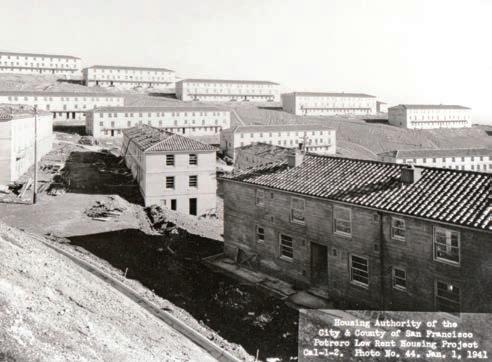

According to the article, “The new programs have brought a whole different crowd to the park. Where you used to see many youngsters and teens from the housing development involved and engaged at the Rec Center, now there are kids who are basically being dropped off by
see letters page 24
No one has done more for San Francisco’s children than Margaret Brodkin, a candidate for next month’s school board election. Brodkin was the director of Coleman Advocates for Children and Youth for more than 25 years. During that time she realized that the needs of children and families were an afterthought at City Hall. Child care, youth jobs programs, health and nutrition programs, and more were funded in good times and put on the back burner in bad times.
Brodkin knew that had to change. In 1991, she mobilized an army of parents, children and youth advocates to collect signatures to get the Children’s Amendment – setting aside guaranteed funding for children and youth programs – on the ballot. When the advocates delivered 68,000 names to City Hall, the petitions piled high in little red wagons, politicians started calling Coleman Advocates asking to sign on as sponsors. The measure won big, children’s issues gained a permanent prominence in San Francisco, and Brodkin’s stature as a dedicated children’s advocate was established.
Brodkin helped establish the City’s Department of Children, Youth and Their Families (DCYF) – which she directed from 2004 through 2009 – Wellness Centers in San Francisco high schools, children’s and youth programs in every neighborhood, and salad bars in school cafeterias, among other things. Her work was instrumental in developing and passing Proposition H, which provides general fund money to San Francisco schools, as well as school bond measures and a parcel tax that improved teacher pay. All told, her leadership has been key in bringing more than $1 billion in services to San Francisco’s children, youth and families.
Brodkin and her DCYF team worked with other agencies to write the grant that exponentially increased after-school funding in San Francisco. If it hadn’t been her leadership, money would have been left on the table instead of being used to support San Francisco families. Brodkin wants to provide a seamless, equitable after-school offerings at every San Francisco public school.
Brodkin’s current employment, and passion, involves working to create “community schools;” schools that provide wraparound services on site from morning until night, rather than locking the doors at 3 p.m. Brodkin directs the privately funded New Day for Learning, which is working with a group of schools to enhance services to all families, especially low-income ones.
Brodkin’s career has left her well-versed in lobbying for funding; a critical skill for a school board member. She oversaw DCYF’s $100 million annual budget, knows City
At The Good Life Grocery, as at any retail business, we deal with whoever comes in the door. That runs the gamut from costumed individuals, people with service animals, the elderly, and those in a hurry. It can be slow or busy, but merchants welcome all comers. These are our customers. It’s when the traffic stops, the trouble begins.
When trouble presents itself outside our doors, merchants are faced with a situation they cannot control and the police cannot stop. On Haight Street, merchants have been plagued by young, aggressive gangs with pit bull dogs that camp on the sidewalks and intimidate passers-by and nearby residents. When people complain, the police seem powerless. Merchants fear retaliation; their customers disappear.
Apparently, asking nicely for people to move hasn’t worked. So in typical San Francisco fashion, we call in the politicians, the lawyers, and the experts. With such an abundance of talent, you might hope that a consensus could be reached. Instead, enough signatures were gathered to place Proposition L – civil sidewalks – on the ballot. Then the San Francisco Board of Supervisors, fearing that common sense might prevail, added Proposition M – “community policing” – as a “poison pill” designed to defeat Proposition L. Proposition L clarifies the law so that police can cite people who behave badly in public, block the sidewalk, and harass passersby. Proposition M is a micromanaging ploy that would effectively cancel out Proposition L if it gets more votes.
This is a common sense issue. We don’t need politicians, lawyers, and experts to divine that when walking down a sidewalk and being confronted by a gang with threatening dogs that there’s a problem. We pay top dollar for a professional police force, and then we strangle them with esoteric legalese that prevents them from executing even the simplest of police procedures: moving people along.
The level of rhetoric about this issue is almost comical. If Proposition L passes police won’t be confiscating lemonade stands. Girl Scouts won’t be hiding in garages (Pssst, wanna buy a cookie?). Tourists won’t be marched off to the hoosegow for consulting a map. But the police will be able to confront and disperse people who choose to make life miserable to the residents and merchants in our neighborhoods.
Supported by more than 25 merchant and neighborhood organizations and hundreds of individual merchants and residents, Proposition L is a rational approach to addressing uncivil behavior on our City’s streets and sidewalks. Law-abiding citizens should be able to walk down a side-
The San Francisco Unified School District (SFUSD) has adopted a new system for assigning students to elementary schools. Under the approach, each school has an attendance area. Potrero Hill families will generally be assigned to Starr King, while, under the district’s most recent proposal, incoming kindergartens residing in Dogpatch will be placed at Daniel Webster. Priority for placement into general education (GE) programs at these schools first goes to the siblings of current students, second to students who live in the attendance area and who attended its onsite SFUSD pre-kindergarten program, third to families living in census tracts in which students score the lowest on standardized tests (CTIP 1), fourth to students with live in the attendance area, and finally to students living in areas where the number of students exceeds the capacity of nearby schools.
There’s no guarantee that a child will be placed into a school in their attendance area. Overflow students will be placed into the nearest school with open slots. Those wishing to opt out of their child’s assigned public
school can enter a citywide lottery for slots in another public school. Meanwhile, students will continue to be assigned to immersion programs, kindergarten through eighth grade schools, and other “alternative” schools based on a lottery.
The new system is an improvement over the previous approach in terms of transparency and clarity. However, it doesn’t improve the situation for people living in CTIP 2 tracts in Southeast San Francisco, which includes about half of Potrero Hill. Under the new approach, families on the City’s northwest side have preferred access to the GE programs in their areas, many of which are strong: Miraloma, Grattan, and Sherman. Families in CTIP 2 areas could be virtually shut-out of SFUSD’s top GE programs, while having no preferred access to Starr King’s or Webster’s immersion programs. This isn’t equitable. True, the City’s wealthier side has citywide competition for its alternative schools, most of which are heavily middle class. But this is hardly analogous to the situation on the south-
With my daughter now attending kindergarten at Daniel Webster Elementary School, I’ve welcomed my daily journey between my Missouri Street home and the school. It’s a short walk up a steep hill; a wonderful way to start the day and burn a few calories. When she was in preschool I was a slave to my car, traipsing across the City twice daily to the Excelsior. Now she’s at our neighborhood school; I work down the street; my husband works from home. We couldn’t get more local.
After I drop her off at school I like to continue my walk down 20th Street to the View’s office in Dogpatch. But I often feel anxiety, recalling The Good Life Grocery employee who was mugged on this same route just a few months ago. I wonder whether and how I’ll respond if someone harasses me. I carry a wallet, smart phone and house keys, and find myself vacillating between the simple joy of walking and the fear that a random individual will bother me, steal my stuff and potentially harm me in the process.
So far the only trouble I’ve had is with a giant mouse at the end of the 20th Street overpass that wasn’t about to move out of the way for me. But I figure it’s only a matter of time. The community listservs are chock-full of threads about break-ins and robberies, many of which are committed by youngsters. Times are tough, social services have been cut and youth are easily lured into a world of danger. Potrero Hill has periodically been home to crime sprees. A few years ago when I pushed a stroller around our hills I’d make sure to carry only
a house key and a few bucks. I never had had an unpleasant encounter, but I’ve heard of others who have.
While the new Crime and Safety page in the View presents real stories about actual crimes, we’re also constantly bombarded by a media obsessed with bad guys, guns and violence. Zynga’s Mafia Wars – the online game that enables players to form their own mobster family – is making its presence well-known on De Haro Street, down the street from International Studies Academy. The company’s PR Hummer is covered in images of machine guns, cash and rough looking people ready for a fight. Middle and high schoolers are inculcated with the coolness of crime, even on their walk to the bus stop after school. Glorified gangster is the last thing we need around here, yet Zynga is ironically situated caddy-corner to the Police Departments’ Homeland Security Unit.
What to do? Flee to the burbs? Drive everywhere in fear? I love Potrero Hill too much to abandon it, and it feels great to leave my car in the garage. Plus, I hate feeling scared. I have a plan in case I ever get bothered, but it’s not a very good one: put my phone in my pocket and only carry around some cash, no cards or identification, in my purse. I just hope that I’m lucky, that the economy improves, and that the police presence isn’t scaled back too much due to budget cuts. Better yet, I’m hopeful that my neighbors will be out walking their dogs, jogging or pushing their strollers so that there are enough eyes on the street to keep trouble at bay.
Vehicle Registration (Fee): Yes. This reasonable tax will generate much needed revenues.
Earthquake Retrofit Bond $46,150,000 (Bond): No. While it’s hard to be opposed to earthquake retrofits, it’s difficult to judge how financing under this measure would work.
City Retirement and Health Plan (Charter Amendment): No. Pension reform is badly needed, but this initiative is poorly written, and will likely end up in the courts if it’s passed.
Mayoral Appearances at Board Meetings (Charter Amendment): No. It’d be preferable to elect a mayor and supervisors who understand the need to cultivate good relationships.
Non-Citizen Voting in School Board Elections (Charter Amendment): Yes. Many of our school children are in non-citizen families; their parents should have a say in who represents them on the school board.
Election Day Voter Registration (Charter Amendment): Yes. We should do everything possible to increase the number of active voters.
Health Service Board Elections (Charter Amendment): No endorsement.

Transit Operator Wages (Charter Amendment): Yes. This is an appropriate correction to unreasonable charter language.
Local Elected Officials on Political Party Committees (Ordinance): No. Constraints shouldn’t be placed on anyone’s ability to participate in party committees.
Saturday Voting (Ordinance): No. While steps should be taken to expand voting access – by, for example, encouraging absentee balloting –Saturday voting could add upwards of $5 million in election costs. People can already vote at City Hall during the week and on weekends two to three weeks prior to an election.
Hotel Tax Clarification and Temporary Increase (Ordinance): No. While the City needs the revenues, now isn’t the time to impose this temporary tax. Tourists are already spending less money in San Francisco, and would be further dissuaded from visiting our City, leading to job losses.
Hotel Tax Clarification and Definitions (Ordinance): Yes. This initiative closes the loophole that allows people who make hotel reservations over the internet to avoid paying the existing tax.
Sitting or Lying on Sidewalks (Ordi-
nance): No endorsement. Something needs to be done to address the lack of civility on many of our streets. However, it’s not clear that this initiative offers the right solution.
Community Policing and Food Patrol s (Ordinance): No. While it’s hard to be opposed to community policing, the City should give our new police chief the opportunity to develop his preferred policing strategy.
Real Property Transfer Tax (Ordinance): Yes. This is a reasonable tax that’s unlikely to result in job loss.
Proposition 19: No endorsement. Although we’re philosophically supportive, and are deeply concerned about the societal costs – particularly
Proposition 20: No. Let’s see how well the recently
adopted redistricting commission works for the state legislature before expanding
Proposition 21: Yes.
Proposition 22: No.
Proposition 23: No.
Proposition 24: Yes.
Proposition 25: Yes.
Proposition 26: No.
Proposition 27: No. Let’s give the recently adopted commission an opportunity to work.

For the upcoming election, San Francisco voters who live in Supervisorial Districts 2, 4, 6, 8 and 10will use ranked-choice voting to elect their Member of the Board of Supervisors.

Citywide, voters will use ranked-choice voting to elect the Assessor-Recorder andPublic Defender. With ranked-choice voting, the names of all the candidates are listed in three repeating columns on the ballot. This allows voters to rank up to three different candidates for the same office.

want to change your party affiliation
Last day to request a vote-by-mail ballot is October 26
Be
a Pollworker
To sign up, visit www.sfelections.org/pw or call (415) 554-4395.
Learn More!
District 10 Family Forumto African-Americans – of the war on drugs, we have some deep concerns about the legal, economic and social implications of this initiative, and its interaction with federal law. it to Congress.
In the aftermath of the deadly explosition in San Bruno, the California Public Utility Commission has ordered Pacific Gas and Electric Company to inspect all of its natural gas pipelines for leaks. Many of the pipelines run through Southeast San Francisco, along freeway rights-of-ways, as part of a system originally developed in part to serve power plants and gas-dependent industries.

phone, 553.8090; to send a confidential text to the San Francisco Police Department (SFPD), 847411, type in

source of polluting air and green house gas emissions. If the Cable can perform as designed through
year...A group of Dogpatch parents have convinced the San Francisco Unified School District to extend Daniel Webster Elementary School’s attendance area south to include all of the Dogpatch Historical District. The proposed boundaries for the district run down 22nd Street, with children living south of 22nd Street or on the south side of 22nd Street in Starr King Elementary School’s area. Students living in an attendance area receive preference to enter that school’s general education program.
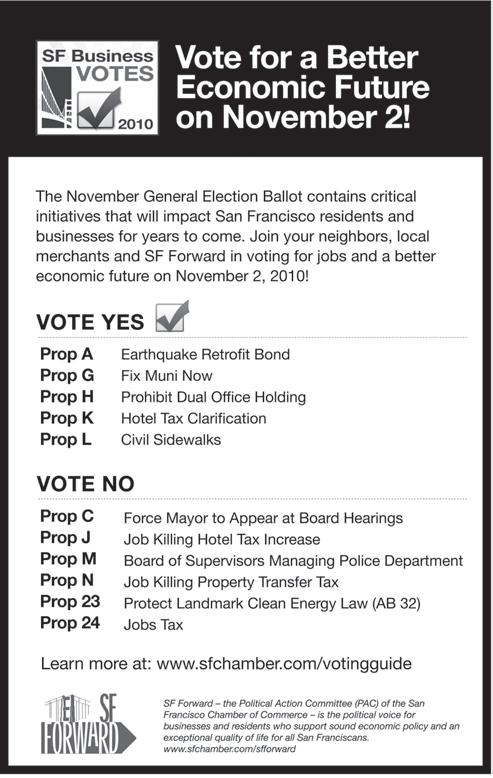
A new AIC tenant, Free Flow Wines, features wine by the glass through their Silvertap wine cask. The Silvertap Wine label is available to restaurateurs in keg form, offering a cheaper, greener and fresher alternative to bottled wine…Sixteenth Street, between Kansas and Arkansas, has emerged as another restaurant node, rivaling the mini-gourmet
see shOrt cuts page 14

District 10 is huge, sprawling east from Showplace Square to Geneva Avenue, and encompassing most of the area west of 101. The roughly 77,000 people living in the district are demographically divided into approximately 18 percent Latino, 21 percent European-American, 28 percent African-American, and 33 percent Asian-American. The district has the highest number of children per household in the City.
Whoever is elected District 10 Supervisor will have to deal with high crime rates – or at least the perception of high rates – extensive redevelopment in Bayview-Hunters Point, and an underperforming educational system. Policies appropriate for Potrero Hill may work less well in Visitacion Valley. The next supervisor will have to balance competing interests to address the difficult challenges facing the district.
Ten of the twenty-one individuals running have demonstrated that they’re viable candidates with crossdemographic appeal. These candidates have raised money, obtained endorsements, been mentioned in the media, and have an online presence or campaign headquarters. The View requested each of these candidates answer a few questions so that voters can get a sense of who they are and what they’ve done for the district. Some provided long lists of achievements, endorsements, and accolades. Others didn’t respond at all. In the latter case brief information was compiled from websites and other publicly available sources. Thanks to Teresa Duque, Kristine Enea, Tony Kelly, Steve Moss, Eric Smith, and Marlene Tran for their cooperation. Due to the View’s publication deadlines, the fundraising data for each candidate are accurate as of August, 31, 2010. For up-to-date information on funds raised and disbursed, visit http://www.sfethics.org/.
Top three or four major endorsers (people or organizations): San Francisco Democratic County Central Committee (SF DCCC) (#2); Aaron Peskin, Chair, SF DCCC; San Francisco Women’s Political Committee; San Francisco African American Democratic Club
Professional background and/or current job: Bachelor of Science (BS), Political Science, Fisk University; Masters of Public Policy and Management, Carnegie Mellon University; managing partner, Power Forward Consulting.
Amount of time living in D10 and in San Francisco (SF)/Bay Area: Besides time away at college, Cohen is a lifelong District 10 resident.
D10 neighborhood she currently calls home: No reply.
Headquarters (HQ) address: 570 Barneveld Avenue, 94124

Top two most notable things you’ve personally done for the people of D10: Served as the assistant executive director, Hunters Point Youth Park Foundation; was a delegate for the California Democratic Party.


D10 community or neighborhood you personally identify most AND least strongly with, and how you will (or have already) reach out to that community/neighborhood with whom you have the least in common: No reply.
Age: 32
Why she’s being profiled: Has many high-level endorsements and is the second highest fund-raiser of all D10 candidates, with an online and campaign office presence.
On the web: http://electmalia.org/
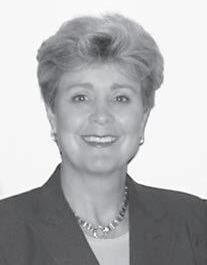
Top three or four major endorsers: None.
Professional background and/or current job: Director, Asian Pacific American Community Center (APACC).
Amount of time living in D10 and in SF/Bay Area: One year living in D-10; three years working in D-10; 17 years in the Bay Area
D10 neighborhood you currently call home: Bayview-Hunters Point.
HQ address: 2798 San Bruno Avenue, 94134. see canDiDates page 7

Top two most notable things you’ve personally done for the people of D10: Duqué has frequently testified before the San Francisco Police Commission on behalf of the community. She’s working with African- and AsianAmerican leaders in an effort to bridge racial divides. Through the APACC she’s developed policies to increase job training and youth opportunities.
D10 community or neighborhood you personally identify most AND least strongly with, and how you will (or have already) reach out to that community/neighborhood with whom you have the least in common: Duqué identifies with all District 10 residents.
Age: 44
Why she’s being profiled: Duque has qualified for public matching funds and has an online presence and campaign office.
On the web: http://www.dq4d10.com

Top three or four major endorsers: BART AFSCME Union, Local 3993; Gerry Crowley, former DCCC member; L.D. Kirshenbaum, co-founder, San Francisco Neighborhood Network; Ollie Burgess, Tedd Hunt and Michael Hamman, Bayview Redevelopment Project Area Committee (PAC); Isabel Wade, Executive Director, Urban Resource Systems.
Professional background and/or current job: Bachelor of Arts (BA), Economics, University of California (UC), Berkeley; Masters in Business Administration, International Trade and Finance, UC Davis; Doctor of Jurisprudence (JD), UC Hastings. Enea is a lawyer, filmmaker, and entrepreneur.
Amount of time living in D10 and in SF/Bay Area: San Francisco resident since 1989; D10 homeowner since 2005.
D10 neighborhood you currently call home: India Basin.
HQ address: Bayview Plaza, 3801 Third Street, 94124.
Top two most notable things you’ve personally done for the people of D10: As an elected member of the Bayview Redevelopment PAC, strengthened the local hiring policy for the Bayview Redevelopment Project Area. Unified a divided community to support historic landmark status for the Shipwright’s Cottage at 900 Innes Street.



D10 community or neighborhood you personally identify most AND least strongly with, and how you will (or have already) reach out to that community/neighborhood with whom you have the least in common: “Involved in the effort to revitalize the India Basin Shoreline, persuading government partners that what our low-income community needs most is income, and that housing alone doesn’t make a neighborhood. Not as familiar with the Portola neighborhood, but have been introducing myself to business owners along San Bruno Avenue, and joined the San Francisco Hep B Free awareness initiative, focusing on outreach in the Portola. I’ve walked D10 boundaries several times, realizing that making the most of shared amenities like McLaren Park calls for close cooperation with neighboring supervisors.”
Age: 44
Why she’s being profiled: Enea has raised more money from Bayview residents than any other candidate, and has an online presence and campaign headquarters

On the web: http://www.kristineenea.com/
Top three to four major endorsers: San Francisco For Democracy; Laborers, Local 261 (#2); Eric Mar, San Francisco Board of Supervisors; Harry Britt, former president, San Francisco Board of Supervisors.
Professional background and/or current job: Research and policy analyst, San Francisco Labor Council, 2007-2010; board trustee, City College of San Francisco (CCSF).

Amount of time living in D10 and in SF/Bay Area: No reply.
D10 neighborhood you currently call home: Bayview.
HQ address: 1133 Mendell Street, 94124.

Top two most notable things you’ve personally done for the people of D10: Created and brought the Green Job Corps program to CCSF’s Southeast Campus with a $930,000 state grant; helped institute CCSF’s Gateway to College Program, which enables students – 55 percent of whom are from D10 – who have dropped out of San Francisco high schools to earn credit towards their high school diploma and a college degree or certificate.
D10 community or neighborhood you personally identify most AND least strongly with, and how you will (or have already) reach out to that community/neighborhood with whom you have the least in common: No reply.
Age: 27.
Why he’s being profiled: Jackson has raised the third-highest amount of funds, has a campaign office and online presence, and a track record as an elected official.

On the web: http://www.votechrisjackson.com

Top three or four major endorsers: Potrero Hill Democratic Club; San Francisco Tenants Union; John Avalos, John Campos, and Eric Mar, San Francisco Board of Supervisors; San Francisco Green Party.
Professional background and/or current job: BA, American Studies, Stanford University; founder and director, Thick Description.
Amount of time living in D10 and in SF/Bay Area: Born in San Francisco, returned to the City in 1989, and has lived in Potrero Hill since 1994
D10 neighborhood you currently call home: Potrero Hill
HQ address: 824B Carolina Street, 94107


A planting party held last month in San Francisco’s newest neighborhood launched the much-anticipated makeover of a neglected half-acre of California Department of Transportation (CalTrans) property at the 280 northbound on ramp, located at Indiana and 25th streets. The vacant lot is being transformed into a green space, where neighbors will be able to enjoy leisure and athletic activities and community events, such as filmsunder-the-stars, art displays and flea and farmer markets.

Steve Moss ship with the California Public Utilities Commission, is installation of a cistern to capture rain water and runoff from neighboring rooftops and the 280 Freeway. The harvested water will be used for irrigation.
The neighborhood surrounding Progress Park was, until mid-century last, a vital industrial area, with manufacturing, service, repair and distribution companies. The de -
BrODKin from page 3
Hall’s inner workings, as well as her way around Sacramento. And she understands the needs of schools like Daniel Webster and Starr King, which serve diverse and often highneed communities. Brodkin has unparalleled experience to prepare her for serving on San Francisco Unified School District’s Board of Education. Please join me in supporting her.
Stacey Bartlett is a founding member of the Potrero Residents Education Fund. Her children attend Daniel Webster Elementary and Potrero Kids, where she serves as the administrative director.
assignMents from page 3
east side, where all of our school’s thriving programs are immersion.
l/M from page 3
walk in any neighborhood without fear or threats of intimidation. Thugs with dogs shouldn’t trump this basic tenet of society. Civil sidewalk laws work in Berkeley, Seattle, and dozens of other cities. These laws don’t target homelessness, they target bad conduct. Police need this tool to help solve problems which frustrate society but don’t reach the level of criminality.
Lester Zeidman co-owns The Good Life Grocery.
Progress Park will incorporate colorful flower beds, fragrant herb gardens, pathways and stretches of green space. Dogs and their human companions will be welcome at a designated off-leash area. Designed by Kuth Ranieri Architects, efforts to create the park were led by a neighborhood volunteers working under Caltran’s Adopt a Highway program, with assistance from the San Francisco Department of Public Works, and the San Francisco Parks Trust acting as the fiscal agent. One of the plan’s key features, being developed in partner-
cline of shipbuilding and other industries that thrived along the Central Waterfront left vacant buildings and unused stretches of land just south of Dogpatch. The neighborhood’s rebirth began roughly a decade ago with the development of live/work loft projects. Three years ago the Muni’s T-Line began service along Third Street.
In addition to several condominium projects, the area now is home to restaurants, cafes and new economy businesses. Progress Park is expected to be a hub of activity, and anchor a string of pocket parks to be developed along 24th Street to Warm Water Cove. Planting in the park will continue over the next few months as portions of the property are prepared with soil supplements.
this wonderful 2 bed/1 bath home exudes original charm. Desirably located with water views, a large flat backyard and a 2 car tandem garage—it’s just waiting for a loving owner’s personal touch. Please call for showing schedule and more information.

Claudia Siegel is more than just a realtor®; she’s your Potrero Hill neighbor. She’s lived on the hill for 14 years as a parent, dog owner and green-certified professional, and she truly cares about the neighborhood. and her keen perspective on our unique real estate market is as sharp as ever.

No matter what your goals, she’ll work to make your transaction a successful one. Whether you are selling or buying, she will work tirelessly to ensure that you get the best results possible.
Buying or selling a home in San Francisco is a big deal; why not trust your business with a neighbor?

The elementary school student assignment system is apparently a done deal. But there’s hope. Potrero Hill has a fantastic parent base that will likely put more resources into Webster’s and Starr King’s GE programs, redressing the class schisms that exist between GE and immersion tracks. But whatever your feelings about school choice and the benefits of immersion, Southeast San Francisco’s CTIP 2 residents got the short end of the assignment stick.
Elizabeth Freeman is Professor of English at the University of California, Davis. Her daughter will enter kindergarten in Fall 2011.
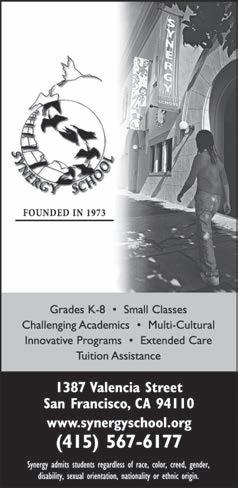
American College of Traditional Chinese Medicine (ACTCM) celebrates its 30th anniversary this year. The first college in the country to offer a master of science in traditional Chinese medicine, ACTCM is among a handful of schools of higher learning that may soon be accredited for a doctoral program in acupuncture and oriental medicine (DAOM). The doctoral program – which will graduate its second class next year – provides advanced education in TCM, with an emphasis on integrative medicine, and offers specialty training in women’s health, pain management and dermatology. The college’s main campus is at 455 Arkansas Street, with a satellite campus in Pioneer Square at De Haro Street. ACTCM also runs a community clinic on Connecticut Street.
“It’s amazing to see how far we’ve come, considering how little the college started with,” said Lixin Huang, ACTCM’s president. “We’re doing things now that were impossible 20 years ago and unimaginable 30 years ago. The (DAOM) program is an example of that. No one would have thought that possible in the beginning, because there were so many struggles for just the basic things that make education possible.”
According to Huang, when
 By Frank Gilson
By Frank Gilson
cultures, with the ultimate goal of reducing violence.

ACTCM enrolled its first class of 34 students in 1981, it received little support from the United States Department of Education, the mainstream medical community or the local population. It was difficult to obtain suitable textbooks and other resources. With no financial aid available, students studied in the evenings after working fulltime jobs during the day.
Now, about 80 percent of ACTCM’s 300-member student body receives some form of financial aid.
And, because in the early-1980s the practice of traditional Chinese medicine was viewed with skepticism, there were few patients in the college’s clinic for students to treat. “We would get maybe 20 or 30 patients a week, mostly Chinese,” Huang said. “The public at large did not yet value or accept TCM. Now, our patients come from all walks of life – very diverse – and we treat about 1,200 a month. That is tremendous change.”
As the public’s acceptance of traditional Chinese medicine has grown so too has mainstream western medical institutions’ willingness to work with ACTCM students and graduates. ACTCM currently places students at the California Pacific Medical Center, and has graduate students at Kaiser Hospital. “Now, the medical institutions come to us,” Huang said. “Our
Celebrating its 20th anniversary, the Potrero Hill Festival returns to 20th Street on October 16th. For many years the festival was held on Southern Heights Street, directly in front of the Potrero Hill Neighborhood House (NABE). Last year a group of merchants and Potrero Hill and Dogpatch residents – including Keith Goldstein, president of the Potrero Hill Association of Merchants and Business, Susan Eslick, and Edward Hatter, the NABE’s executive director – moved the festival a little to the north, and brought in more vendors and kids and adult activities. Adam Straus, of Straus Events, was hired as the event organizer. According to Straus, who works on events throughout the City, the Potrero Hill festival is special, calling it “the little festival with the big view and an even bigger heart.”
The festival serves as a fundraiser for the NABE’s programs. This year, event organizers hope to raise monies to re-start the Experiment in Diversity program, which helps foster a better understanding among young people of other

This year’s event will kick-off with a traditional New Orleans style mimosa brunch at the NABE, from 9 am to 1 pm, hosted by California Culinary Academy students. Swing and acapella musicians will provide entertainment. Shuttle buses will be available to take guests to the festival on 20th Street between Missouri and Wisconsin, which is expected to draw upwards of 7,500 participants. Local artists, merchants and restaurants will be featured, with neighborhood businesses providing generous sponsorships. According to Goldstein, “our local merchants have really stepped up with sponsorships this year. They want to support the programs at the NABE and they see the festival as a huge advertisement for Potrero Hill”.
The festival provides a day-out for the whole family, with activities for kids and adults: a petting zoo, pony rides, dunk tank, jumpy house, face painting and music on two stages. The main stage will feature local favorites The Soul Delights and returning blues legend Bobbie “Spi-
canDiDates from page 7
Top two most notable things you’ve personally done for the people of D10: Led the Potrero Boosters Neighborhood Association for seven years; created and facilitated Plan Potrero Hill, a year-long series of neighborhood workshops focusing on community-based planning
D10 community or neighborhood you personally identify most AND least strongly with, and how you will (or have already) reach out to that community/neighborhood with whom you have the least in common: Most: “I’d have to say Potrero Hill. Least: Visitacion Valley, and I’ve already been working with leaders in that community to organize around violence prevention and cuts in neighborhood services, in addition to meeting neighbors multiple times a week.”
Age: 47
Why he’s being profiled: A strong list of endorsements, a campaign office and online presence, and the most money raised in Potrero Hill of all D10 candidates On the web: http://tonykelly2010.com/
Top three to four major endorsers (people or organizations): SF DCCC (#1); SF African American Democratic Club (#2); Bayview Hunters Point Democratic Club (#2)

Professional background and/or current job: BA, Intracultural Communications, San Francisco State University; JD, Golden Gate University; currently a civil rights attorney.
Amount of time living in D10 and in SF/Bay Area: Lived in San Francisco since 1995. Grew up in San Jose.
D10 neighborhood you currently call home: Potrero Hill.
HQ address: 1459 18th Street Number 204, 94107.
Top two most notable things you’ve personally done for the people of D10: No reply.
D10 community or neighborhood you personally identify most AND least strongly with, and how you will (or have already) reach out to that community/neighborhood with whom you have the least in common: No reply.
Age: 34
Why he’s being profiled: High-powered endorsements and an online presence and campaign office, but only $745 raised in 2010, with the least amount in matching funds of the ten candidates profiled.
On the web: http://www.dewittlacyforsupervisor.com/
Top three or four major endorsers: Carpenters Union Local 22; Small Business Advocates; San Francisco Police Officers Association; Rescue Muni.
Professional background and/or current job: BS, Conservation of Natural Resources, UC Berkeley; Master of Public Policy, University of Michigan; Adjunct Lecturer, San Francisco State University/Mills College public administration programs, 1997 – 2009; Executive Director, San Francisco Community Power; Publisher, Potrero View; Policy Analyst.

Amount of time living in D10 and in SF/Bay Area: Grew up in Bay Area. Moved to Potrero Hill in 2000, to Mission-Dolores in 2007, and back to Potrero Hill in early 2010.
D10 neighborhood you currently call home: Potrero Hill.
HQ address: 291 Connecticut Street, 94107.
Top 2 most notable things you’ve personally done for the people of D10: Helped close power plants; saved working families and small businesses tens of thousands of dollars annually on their utility bills.
D10 community or neighborhood you personally identify most AND least strongly with, and how you will (or have already) reach out to that community/neighborhood with whom you have the least in common: “I’ve
spent the last ten years helping working families and small businesses in Bayview-Hunters Point, Dogpatch and Potrero Hill save money on their utility bills, as part of an effort to close the Hunters Point and Potrero power plants. I’ve more recently spent time in the rest of the District, and am the only candidate to secure 1,000 signatures from voters through the District to place my name on the ballot, 40 percent of which came from Bayview-Hunters Point and Visitacion Valley.”
Age: 49.
Why he’s being profiled: Strong endorsements, an online and campaign office presence, and the highest amount of matching funds of any D10 candidate.
On the web: http://mossfordistrict10.com/
Top endorsers: David Campos and Ross Mirkarimi, San Francisco Board of Supervisors; SF DCCC (#3); San Francisco Bicycle Coalition; San Francisco League of Conservation Voters.
Professional background and/or current job: Executive Director, Green Depot; board member, Biofuel Recycling Cooperative; arts and entertainment editor, BeyondChron.org.

Amount of time living in D10 and in SF/Bay Area: Born in Italy, raised in Washington, DC. Moved to San Francisco in 2002, to the Western Addition in 2003, and to D10 in January, 2009.
D10 neighborhood you currently call home: Dogpatch.
HQ address: 2000 Oakdale Avenue, 94124.
Top two most notable things you’ve personally done for the people of D10: Converted the City and County of San Francisco’s diesel fleet to biodiesel in 2007; converted the San Francisco Bay Railroad to biodiesel in 2008; removed thousands of tons of toxic material from Hunters Point Shipyard.
D10 community or neighborhood you personally identify most AND least strongly with, and how you will (or have already) reach out to that community/neighborhood with whom you have the least in common: “I identify with Bayview, (I actually first came there from LA in 1999, lived briefly on Carpenter Court with my wife’s family; We went back to DC from 2000-2002) and Dogpatch, (I have many friends, artists and musicians here). Least strongly with the D10 part of Mission Bay; too new and empty, but not for much longer. I’m on the Mission Bay CAC and getting to know the issues and residents there better.”

Age: 53.
Why he’s being profiled: Strong endorsements coupled with an online and campaign office presence, but collected the least amount of money from within D10 of all candidates
On the web: http://ericsmith10.com/
Top three to four major endorsers: Alice B. Toklas LGBT Democratic Club; Mayor Gavin Newsom; Bayview Hunters Point Democratic Club.
Professional background and/or current job: BA, Sociology, UC Berkeley; Bay Area Rapid Transit District 7 Board Director
Amount of time living in D10 and in SF/Bay Area: Lifelong D10 resident.
D10 neighborhood you currently call home: Bayview.
HQ addresses: 1 Rhode Island Street, 94107; 1599 Revere Avenue, 94124
Top two most notable things you’ve personally done for the people of D10: As a community banker, worked with small businesses in the district.
D10 community or neighborhood you personally identify most AND least strongly with, and how you will (or have already) reach out to that community/neighborhood with whom you have the least in common: No reply
Age: 51
Why she’s being profiled: High-powered endorsements, two campaign offices and an online presence, the third-highest amount of money raised from within the district and a large amount of matching funds, and is an elected office-holder.
On the Web: http://www.sweetforsupervisor.com/
Top three to four major endorsers: CCSF Trustee Lawrence Wong; Chinese American Citizens Alliance; Westside Chinese Democratic Club; Visitacion Valley Asian Alliance.
Professional background and/or current job: Retired after more than 30 years of full-time teaching at San Francisco Unified School District, and part-time at CCSF; was formerly elected to the 12th DCCC and served two terms as Mayor Willie Brown’s appointee to the Immigrant Rights Commission.

Amount of time living in D10 and in SF/Bay Area: Moved to Visitacion Valley more than 20 years ago
D10 neighborhood you currently call home: Visitacion Valley.
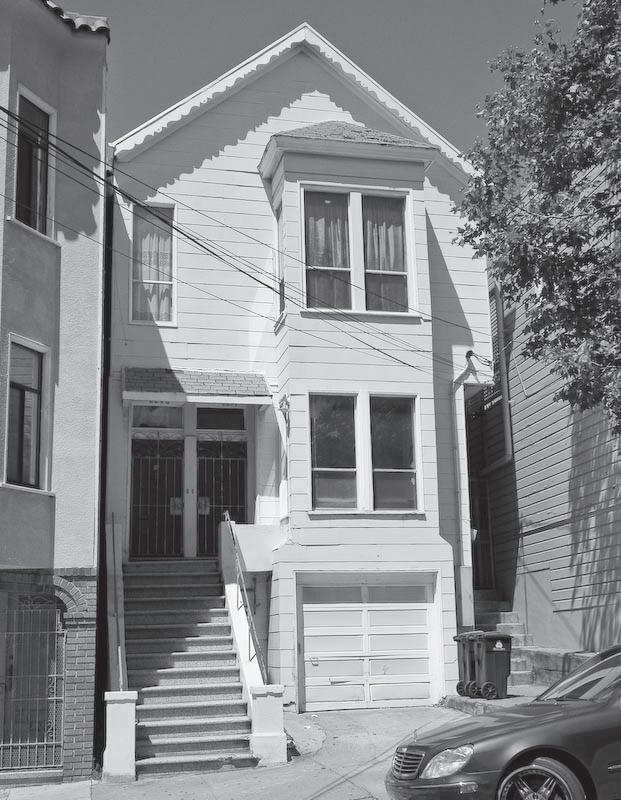
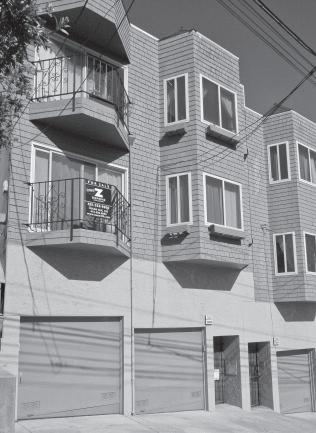
HQ address: her home.
Top two most notable things you’ve personally done for the people of D10: Tran has fought for improvements to MUNI, stronger crime prevention, expanded educational services, job training, parks, language access, senior, and youth and minority services; served as a community advisory board member of both Ingleside and Bayview police precincts, initiating bilingual surveys, mobilizing residents to attend monthly police safety meetings and encouraging victims to report crimes; donated part of her storefront property on Leland Avenue as the first One-Stop contact.
D10 community or neighborhood you personally identify most AND least strongly with, and how you will (or have already) reach out to that community/neighborhood with whom you have the least in common: “I identify most with Visitacion Valley. However, the issues and services I advocated benefited residents from many communities in District 10, including MUNI (my 5,000 signatures of support extended the 8 express lines to seven-day services), crime prevention/intervention, CCSF classes, McLaren Park, job training, senior, and youth and minority services.”
Why she’s being profiled: Tran has raised more money from within Visitacion Valley than any other candidate.
On the Web: http://www.marlenetranforsupervisor.org/
Susan is both your Potrero Hill neighbor and Realtor®. With her keen business sense and warm approach to client service, she is at once upscale and down to Earth. Kind of like Potrero Hill.

Large 2 Unit Building on South Slope PotreroHill
Upper 2 bedrooms, 1 bath
Lower 2 bedrooms, 1 bath
Kitchens updated in both units
Walking distance to SF General
Easy access to both 101 and 280
Upper delivered vacant at COE
Huge garage for 2-3 cars
Great opportunity!
Call for details/showings.
2204-2206 23rd Street

Listed for: $799,000
Single Family North Slope Victorian
2 bedrooms and 1 bath
Foyer with anaglyphic wainscot
High ceilings and picture railings
Wood floors and pocket doors
Outdoor deck and serene garden
Garage w/parking for 2 cars
Abundant storage area in garage
Walk to Whole Foods/restaurants
www.2009-17thStreet.com
2009 17th Street

Listed for: $799,000
Two-Level Potrero
Condo with Views
2 bedrooms, 2 baths

2 levels of living space
Remodeled kitchen & bath
Open living-dining-kitchen
Master bedroom suite w/private, green outlook
Views of Twin Peaks/SF Hills
Garage & extra storage
www.1085deharostreet.com
1085 De HaroStreet
Listed for: $629,000
And with nearly 30 years of San Francisco real estate expertise in the city’s most exclusive neighborhoods, and of course her own home base of Potrero Hill, it’s no wonder she’s the first person so many San Franciscans turn to for guidance when they decide to buy or sell property.
She’s been at the top of this game for years; when only the best of both worlds will do, call Susan Olk.






down to $10,000 from $40,000 a year ago, the second consecutive year donations have faded. The NABE also lost its annual $3,000 seed money from the San Francisco Arts Commission to assist in organizing the Potrero Hill Festival. The festival, held in October, is one of the NABE’s largest fundraising activities

“We’re doing what we have to do to maintain, and we know we’re not alone in that regard; times are tough for a lot of people,” said Hatter. “But it hurts all of us to see people not getting the services they need. Just as a human being, it starts to get to you. Personally, I don’t sleep these days.”
According to Hatter the loss of teen-focused programming has caused most of his insomnia. Eliminated were the Youth Moving Forward program, which assisted 60 predominantly African-American youth with substance abuse and anger management issues, and the Save Our Schools program, a truancy and drop-out prevention effort that was to begin operating at International Studies Academy and Downtown High School this year. Both programs were funded by DHS.
“We didn’t really have a choice (in cutting those programs),” said Skip Charbonneau, who has been active with the Neighborhood House since 1970, and president of the organization’s board of directors for the past two years. “When the funds for a particular program go away, the program goes away. That’s sort of the position we put ourselves in by relying too much on City contracts and not finding more diversity in our funding. Moving forward, that’s something we will have to do, and that should give the NABE more flexibility in terms of which programs to grow and which programs to cut.”
The Experiment in Diversity program was a temporary victim of budget cuts; a $71,000 grant – sponsored by the San Francisco Board of Supervisors and distributed through the Department of Children, Youth and Their Families – announced in late-August has given it new life. Experiment in Diversity is an afterschool life skills program for youth ages 12 to 18 who are either on probation or considered disadvantaged.
“The real worry with losing these programs is that now you have just that many more teens loose on the streets with fewer positive outlets for their energy,” said Hatter. “The community is always concerned with something violent erupting with teens, and a lack of ongoing, orchestrated activities just kindles the fire.”
To illustrate the potential impact on the community of teens with idle time, Hatter said the NABE has been burglarized six times this year.
“There’s nothing here to steal, but it’s the destruction that is alarming and that we can‘t handle,” said Hatter.
“These are the types of things young people do when they have nothing else to do.”
According to Hatter the loss of teen programming effects some of the NABE’s other work. For example, profits from fundraising activities in the youth programs helped finance the senior nutrition program, which provides daily lunch to 28 people throughout the week. To make up the difference, Hatter said the NABE will likely substantially increase its rates for use of the facility beginning in January.
Organizations like the Potrero Hill Boosters, Potrero Hill Democratic Club and Rebuild Potrero use the NABE’s theatre for their monthly meetings. Currently, the theatre rents out at $110 per hour. Hatter said he expects the new rate will be $200 per hour. Other organizations, like Alcoholics Anonymous and Narcotics Anonymous, rent rooms at the NABE for weekly meetings at a $50 per hour rate. According to Hatter that rate will likely double next year.
“It’s definitely not something we want to do,” Hatter said. “But when the lights go on, the light bill goes up. Given our financial situation, we just cannot afford to subsidize the nonprofits anymore.”
The NABE is also considering selling a small lot it owns across the street from the center. “It’s the last piece of property [the Neighborhood House] owns,” Charbonneau said. “We were hoping to put that money away for a rainy day, but the rainy day is here. We desperately need the money right now.”
Those interested in making a donation to the Potrero Hill Neighborhood House can do so by contacting 826.8080 or info@phnh.org. Donations can also be made online through PayPal.
Many neighbors and friends have labored on the steep slopes surrounding McKinley Square Park in an on-going effort to improve the park. But the weeds continue to grow, and the City gardener’s job is
disabilities by promoting self-determination, dignity, and quality of life. “We are always looking for more opportunities to introduce our clients to new skills, provide exposure to new opportunities and to learn and have different experiences out in the community. Volunteering at
never done. Coordinating efforts to help make McKinley Square a better park can deflate even the most dedicated volunteers. Volunteers can be recruited – Joyce Book, McKinley Square Park Foundation’s executive director deployed a website, VolunteerMatch – but to work in the park a series of permissions must be obtained, involving a number of people.
Book started with Steve Cismowski, who heads the Neighborhood Service Area of the Recreation and Park Department (RPD). Cismowski liked the idea of more volunteers, but didn’t have the staff to organize them. The next step was Eric Hill, acting supervisor for McKinley Square. He identified areas where work was needed. Then came Kristen Bowman, RPD’s volunteer coordinator, who signed on to help get the project off the ground.
VolunteerMatch attracted volunteers, including The Arc of San Francisco. The Arc’s mission is to serve people with developmental
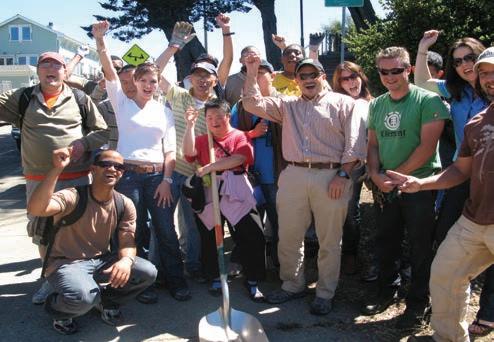
McKinley Square Park really matches that goal,” said Heather Haberlin, The Arc’s Resource Developer.
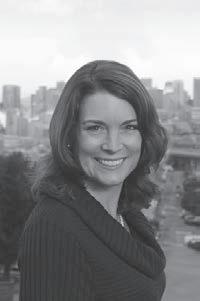
“I have a godson, Roland, with Down syndrome and he loves to garden,” said Book. “He just loves it. If I let him, he would garden for days and nights. Add some music and a slice of pizza here and there and Roland would live in the garden if I let him.”
The Arc proposed to provide more than 20 volunteers, with one instructor for every five clients. RPD agreed to give it a try. Cismowski planned a project focusing on the park’s lower western paths – near 20th Street and San Bruno Avenue – where the off-leash dog areas are located.
It was like a small army had descended onto the park. Rakes scrapped the ground, debris was removed, hands got dirty and sweat appeared on brows: the activity took place on the year’s hottest day.
see McKinley page 21
shOrt cuts from page 5
ghetto that’s being created in Dogpatch. Breakfast-centric purveyor Sally’s , at the corner of De Haro, anchors the strip, with Pizza Nostra located a few doors down, and What’s Up Dog feeding the lunch crowd from a tiny triangle in the parking lot. Technique has replaced Careme 350, which succeeded Bistro 350, at the California Culinary Academy’s Rhode Island Street outlet. The restaurant offers a five-course fixed price dinner for just $20, Tuesday through Friday from 6 to 8 p.m. Dos Pinas Taqueria, also on Rhode Island, has garnered four stars on Yelp for its Mexican food. Lunch is being served at Wolfe’s Lunch and Axis Cafe, both of which are adjunct to a corner park at Arkansas Street. There’s Live Sushi, at 17th and Kansas streets, and Horatius, which serves breakfast and lunch Monday through Friday and offers weekend brunch, with a wine bar during the week.
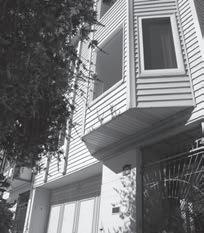

Last month the View reported that Flor De Lis closed shop, when they actually just moved to 457 Texas Street. Retail operations have been suspended, but the florist continues to take orders and make deliveries: 626.4242…In the same issue Starr King Elementary School’s ParentTeacher Association president was incorrectly identified in “Neighborhood PTAs Work to Fill School Funding Gaps.” His correct name is Pierre Barolette…In the August View the Steve Moss for District 10 Supervisor campaign purchased an advertisement that included the statement, “Edits and publishes this very paper (but got its endorsement on his own merits).” Our neighboring paper, the SanFranciscoBayGuardian, called to ask when, exactly, and through what process, the View rendered this endorsement. While the ad was tongue-in-cheek, the View is gratified to know that it’s read by the Guardian




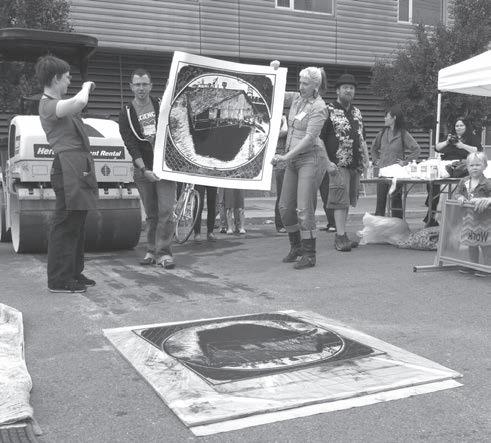
Festival from page 9
der” Webb. The second stage will feature teen entertainment, with music, dancing, and spoken word. Local performing arts groups, such as Fei Tian Traditional Chinese Dancing and the Swift Gospel Choir from Enola Maxwell School, will perform. Rocketfish, Goat Hill Pizza, Pera and others will present delectable tastes.
Admission is free. Information: www.potrerofestival.com.

carpenters from front page matched by today’s Great Recession. “Either you’re working or you’re not,” Mulligan said. “That’s why construction is an economic indicator.”

In a good economy, 80 members might be out of work, according to Mr. Uribe, a union member who preferred to share only his last name. Mulligan said at the turn of the century, a construction boom created a shortage of skilled trades people, making it easy for members to show up at the union hall and get sent out for jobs immediately. But on this day in mid-September, the number of jobless members had reached 255. Eighteen months ago, Mr. Uribe had signed up for roll call, placing 400 on the list. Since then, his name has inched to number 145. “In a good economy, I could be working in two weeks,” he said.
Local members like Eric Castro have resorted to odd jobs to make ends meet. Castro hasn’t had a union assignment for two years, and is num-
ber 212 on the list. “Before October 2008, I was working all the time,” said Castro, who worked for a company that went out of business when the recession hit. A 16-year member, he helped build ramps for the Third Street light rail and retrofitted public schools and universities. “Then suddenly, nothing. Nothing was being built,” he said.
Castro has brought in some income by building fences and fixing porches, acquiring those jobs through friends, though he says competition is fierce. “I have not been getting benefits,” said Castro. “I have no health insurance.” Members obtain healthcare and retirement benefits if they work at least 100 hours a month, paying for coverage through their hourly wage. While he’s been out of work, Castro’s watched the San Leandro home he bought before the recession plummet in value. Luckily, he says, his wife works as a teacher. It’s a relief other carpenters waiting in the roll call room expressed.
“If my wife wasn’t working, it would be up shit creek,” said Bobby Felix, a father of four who lives in Bayview-Hunters Point, who sat in the union hall with his three-year-old son, eating a complimentary pastry.
Robert English, 52, also a Bayview-Hunters Point resident, is the primary financial support for his girlfriend. So far, he’s relied on savings; and those have dwindled to nothing. After waiting on the roll call list for nine months, English was called in April to work the Loewe’s construction project on Bayshore Boulevard, a job that lasted four months. According to English, he was one of the first ones hired and the last ones laid-off from the job. “They wanted to bring their own people,” he said. “I guarantee 75 percent don’t live in San Francisco.” He’s now 189 on the list. “If you’ve been out of work for three years and then go out and work one week, you’re off the list,” said English.
In a time when roll call moves at
Remodeled 2-bedroom / 1-bath home. Open floor plan with gourmet kitchen; large attic space ready for EZ

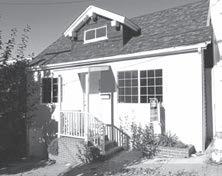
a snail’s pace, a job’s length and scope matters, especially when a member can only turn an unwanted job down once. After that, they’re obligated to take the next job.
As English grabbed a pastry, he told Bobby Felix he needed to talk to him. “You gotta sign up,” English urged Felix, referring to a hazardous material training that was coming up. “You can’t work on the [Hunters Point] shipyard if you don’t get the training,” he said, handing Felix a flyer for the training.
According to Mulligan things aren’t going to get better anytime soon. A handful of fully entitled downtown high rises are waiting for financing, which, if it’s secured, would help roll call move a little quicker. Castro is hoping redevelopment at Hunters Point and China Basin will move forward and create jobs. “I see the light at the end of the tunnel,” Castro said. “I’m staying with the union because of the possibility of getting work.”
Large projects like the Doyle Drive replacement, near the Golden Gate Bridge, are putting some members to work, he said. “Even nonmembers benefit from what we do,” said Mulligan. “Unions elevate the standard for everybody else.”
“I gotta have faith in my union,” said Felix. “The economy is going to pick up.” Aside from relying on his wife’s income to make ends meet, he’s also on unemployment. And at 114 on the roll call list, he’s surprisingly hopeful. “Christmas is coming up and I want my kids to have toys under the Christmas tree,” he said.
High-speed broadband access to the Internet empowers, transforms and enlightens.
That’s why AT&T is embarking on one of the largest network upgrades in our history. We’re bringing fiber optic technology built on the global standard of Internet Protocol (IP) to San Francisco.
Your television, cell phone, laptop, PDA, digital video recorder, home appliances and so much more –working better because they work together for you .
We are currently meeting with San Francisco neighborhood groups. To request a meeting or to find out how you can help bring AT&T U-verse® to your neighborhood, please contact us today.
att.com/IPnetwork4sf









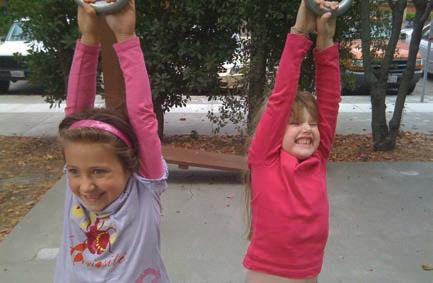










September 30 through November 19
Theater: Shocktoberfest!
2010 Kiss of Blood
Thrillpeddler’s Halloween-themed show features three one-act plays in the Grand Guignol tradition: Kiss of Blood, Lips of the Damned and The Empress of Colma. Thursdays and Fridays at 8 p.m.; special Halloween performance on October 31 at 8 p.m. Tickets: $30 - $69. The Hypnodrome, 575 10th Street. Information: www. thrillpeddlers.com.
October 1 - 3
Dance: Traditions Engaged
Chitresh Das Dance Company and Chhamdam present an international festival of classical Indian dance and music. Leading Indian classical dancers and musicians perform throughout the three day series, accompanied by lectures, demonstrations and panel discussions. Performance times and event schedule varies. Tickets: $195 one day pass; $285 two day pass; $340 full package; discounts for multiple tickets, early bird registration and students. Yerba Buena Center for the Arts. Information: www.kathak.org/ traditionsengaged.
October 2
Art: ArtLaunch 2010
Artspan invites you to a kick-off party celebrating 35 years of San Francisco Open Studios. With more than 400 works of art for sale, the event includes an open bar featuring Pernod Absinthe cocktails and food by Thomas John Events. 7 to 10 p.m.
Tickets: Artspan members $35 in advance, $40 at the door; non-members $50 in advance, $60 at the door. 21-years-old and over. SOMArts Main Gallery, 934 Brannan Street. Information: http://artlaunch2010. eventbrite.com.
Community: San Francisco General Hospital Community
Mural Paint-In
San Francisco General Hospital welcomes community members to join hospital staff and patients in a painting project to beautify the construction site along Potrero Avenue. Under the supervision of Precita Eyes Mural Arts Association, the mural will incorporate artwork from neighboring Buena Vista Elementary School. Ages seven and up are welcome. 10 a.m. to 5 p.m. San Francisco General Hospital, 1001 Potrero Avenue at 23rd Street.
October 4
Literary Arts: Feast of Words
SOMArts kicks off the Feast of Words monthly series with storytelling readings, an open mic and potluck. Join co-hosts Lex Leifheit and Irina Zadov, and discover local writers and featured foodies, includ-
ing a Three-Sentence Throwdown. Bring a theme-based work of eight minutes or less for open mic. This month’s theme is healing, in honor of the upcoming Day of the Dead exhibition at SOMArts beginning October 8. Cash bar. 7 to 9 p.m. $10 suggested donation or free with a potluck item. Advanced tickets strongly recommended. 934 Brannan Street. Information: feastofwords. eventbrite.com.
October 5
Community: Community Crime Watch and Public Safety Meeting
McKinley Square Park Foundation spearheads its second annual public safety event. Speakers include the San Francisco Police Department, California Highway Patrol, SAFE Neighborhood Crime Watch Program, among others. 6:30 to 8 p.m. Downtown High School Cafeteria, 693 Vermont Street. Information: www.mckinleysquarepark.org.
October 6
Community: Mission Bay
Retail Block Party
Celebrate Mission Bay at the fourth annual University of California, San Francisco Mission Bay campus retail block party. Live reggae music by Native Elements, an expanded farmer’s market, food specials, give-aways, kids’ activities and more. Chalk Art Contest begins at 11 a.m. 11:30 to 1:30 p.m. Gene Friend Way, between Third and Fourth streets. Information: www.campuslifeservices.ucsf. edu/retail.
October 9
Health: Breast Health Discussion
October is Breast Cancer Awareness Month and San Francisco Natural Medicine is offering a free breast health presentation by Nancy Gardner, PhD. Gardner is a worldrenowned speaker and thermologist. Fee-based breast thermography sessions will be available after the talk. 2:15 to 3:15 p.m. 1615 20th Street. Information: www.SFnatmed.com.
October 13
Art: Art Reception with Alica Buelow
Head to Farley’s for an art reception featuring Alica Buelow. Specializing in mixed media collage and illustration, Buelow combines found objects with photographs, drawings and more. 7 p.m., Free. 1315 18th Street.
October 16
Community: Potrero Hill Festival
Kick off the 20th annual Potrero Hill Festival with a New Orleans Cajun brunch complete with Dixieland music at the Potrero Hill Neighborhood House, catered by the California Culinary Academy. The festival continues on 20th Street with music, activities for kids, local craft vendors
and more. Brunch 9 a.m. to 1 p.m.; street fair 11 a.m. to 4:30 p.m. Brunch tickets are $5 for kids over 7; $10 for adults. Potrero Hill Neighborhood House, 953 De Haro Street. Festival on 20th Street between Wisconsin and Missouri streets. Information and tickets: potrerofestival.com.
October 16 – 17

Dance: San Francisco
Trolley Dances 2010
Potrero Hill’s own Kim Epifano’s Epiphany Productions presents the seventh annual San Francisco Trolley Dances. Experience the Bay Area’s finest dance troupes at various stops along the N Judah line. Beginning at Harvey Milk Center for Recreational Arts, participants are led on performance tours through the Duboce Triangle, Cole Valley and Inner Sunset neighborhoods. Riders disembark at different stops to witness dance performances in outdoor site-specific venues, culminating at the Botanical Gardens in Golden Gate Park. Tours leave every 45 minutes between 11 a.m. and 2:45 p.m. Free with Muni Fast Pass or regular fare of $2; $.75 for seniors and youth; free for children under 4. Harvey Milk Center for Recreation Arts at Duboce Park. Information: www.epiphany dance.org.
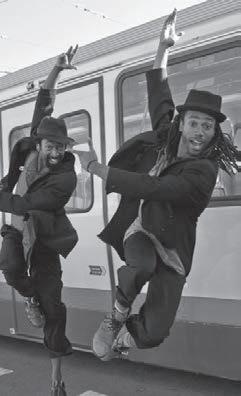
24 at 3 p.m.; special family matinee performance October 24 at 12 p.m.
Tickets: $35 to $40 for reserved seating; $10 family matinee. Opening night reception, $85; gala benefit, $150. Palace of Fine Arts. Information: www.naleihulu.org.
October 18
Music: Kristin Flammio
Farley’s presents Kristin Flammio, a singer-songwriter living in Brooklyn who grew-up listening to her dad’s band playing in the basement. She performs a range of songs from original sappy heartbreak tunes to her own versions of Danzig and Hall and Oates. 8 p.m. Free. 1315 18th Street.
October 23
Community: San
Francisco General Hospital
Seismic Safety Fair
Curious about the new hospital’s seismic safety? Project architects, engineers, builders and other experts will discuss the new building’s safety features. Participants can plan their own family disaster kit and talk to emergency preparedness experts. 9 a.m. to 12 p.m. Free. Hospital cafeteria, second floor of the main hospital.
Health: Food and Nutrition
Ideas for Migraine Prevention
Suffering from migraines? Stop by San Francisco Natural Medicine for a discussion on how to curb them through your diet, led by Andrea Zengion, ND, LAc. 2:15 to 3:15 p.m. Free. 1615 20th Street. Information: www.SFnatned.com
October 29
Community: Farley’s Pumpkin Carving Contest Carve your pumpkin and bring it to Farley’s; no rules, just fun. Prizes for kids big and small. Entries due by 10 p.m. 1315 18th Street.
October 30
Community: Farley’s 20th Annual Pet Parade and Costume Contest
October 16 – 24
Dance: 25 Years of Hula
Potrero-based Na Lei Hulu Ka Wekiu presents six anniversary hula dance performances at the Palace of Fine Arts. Featuring several of their most popular dances from Na Lei Hulu Ka Wekiu’s 25-year repertoire. Opening night includes a champagne reception immediately following the performance. Gala benefit lu’au and silent auction on October 23 at 5:30 p.m. Performance times: October 16, 22 and 23 at 8 p.m.; October 17 and
Dress-up your two- or four-legged friend for a parade and costume contest. Parade begins at 18th and Arkansas and ends at Texas Street, where the Captain Casual Blues Band will be playing and the judging will commence. This years’ celebration will honor those pets that have passed on; a special ceremony will take place in their honor. Parade starts at 1 p.m. Farley’s, 1315 18th Street.
October 31
Community: Halloween
Trick or Treating
Halloween in Potrero always centers around 18th and 20th streets. Kiddos: costume-up and head over to Jackson Park to commence a march up to the central strip. Gather at 6 p.m.; march at 6:30 p.m. Boo!


 By Jim Van Buskirk
By Jim Van Buskirk
Telling Pictures’ offices have been located at the corner of Arkansas and 16th streets for roughly five years, about as long as filmmakers Rob Epstein and Jeffrey Friedman have been working on their latest film, Howl The documentary focuses on Allen Ginsberg’s seminal poem and the ensuing obscenity trial in 1957, which broke down societal barriers.
Although Ginsberg was born in Newark, New Jersey in 1926 and died in New York City in 1997, he had a tight connection with San Francisco. In the mid-1950s Ginsberg traveled to the City, where he met poet Kenneth Rexroth and Peter Orlovsky, who would be Ginsberg’s companion for much of his life. Ginsberg reportedly wrote Howl in the summer of 1955 at Caffé Mediterraneum, a Berkeley coffee house now known as “the Med.” Later that year, he joined five other unknown poets at a free reading at the experimental Six Gallery, a bohemian art space on Fillmore at Union streets that had been an automobile repair shop. Howl came to represent the new counter culture of the Beats: “I saw the best minds of my generation destroyed by / madness, starving hysterical naked, / dragging themselves through the negro streets at dawn/ looking for an angry fix...”
The day after the reading City


Lights publisher Lawrence Ferlinghetti offered to publish the poem. In November 1956 Howl became the independent press’ fourth publication. On March 25, 1957, United States Customs seized copies of the book’s second edition en route from America to England. Two months later Ferlinghetti was arrested, and charged with selling obscene material. The resulting trial, The People v. Ferlinghetti, became a watershed case about freedom of speech, and is the film’s structural linchpin. The media attention stimulated national interest; by 1958 there were 20,000 copies of the poem in print. Howl’s fame provided City Lights with a prestige much larger than the independent press’ size. Ginsberg continued to publish his poetry with the press for the next twenty-five years. There are now more than a million copies of Howl in print.
On the 50th anniversary of Howl’s publication, Epstein and Friedman were approached by Bob Rosenthal, the secretary of Ginsberg’s estate, about turning the story of the poem into a film. Epstein is best known for his Academy Award-winning documentary The Times of Harvey Milk. He partnered with Friedman on Common Threads: Stories from the Quilt, Celluloid Closet, and Paragraph 175.
see hOWl page 21







For making the 2nd Annual Community Action Day a success! The new community garden installed at the Family Resource Center is thriving and people had a great time at the community celebration that culminated in the first outdoor movie night at the Potrero Hill Recreation Center. Thanks to all of you who volunteered your time and energy to planning and executing this event – we couldn’t have done it without you! Special thanks to Recology Golden Gate, Tom Boss and Delony, Tom McCarthy, Nibbi Brothers, Beronio Lumber, City Grazing, and SF Recreation and Parks Dept. If
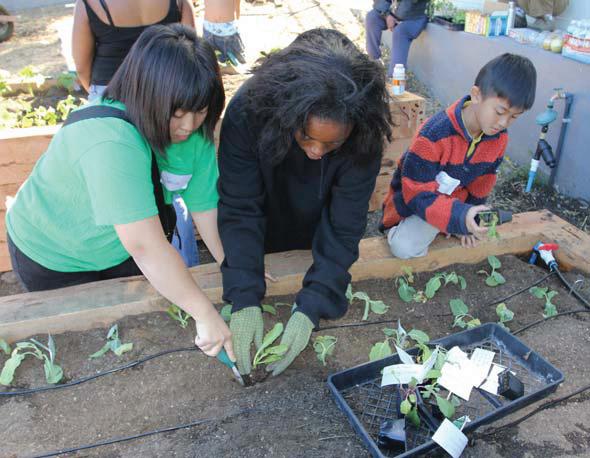
Book coordinated snacks and bathroom breaks. The afternoon evolved beyond weed pulling; joy was taken in work that’s usually drudgery. The shovels didn’t just dig into the ground, they explored the earth. Those who were normally quiet began to talk, and those not shy talked louder. “It is such a pleasure to work with such a hard working group. Our staff was thrilled by the quality and quantity of work accomplished. The Arc is a really fun group and we look forward to the ongoing partnership at McKinley Square,” said Hill.
“I was worried that the heat would lower their enthusiasm,” said Book. But when the vans returned the following week, all the volunteers returned as well. “They are actually more efficient and easier to work with,” said David Lamb, the lone City gardener on week two. Groups formed almost wordlessly to collect and move large bags of debris to a collection point at the top of Vermont Street. The weather was cooler and the sunshine warmed everyone. While the hard work was getting done outdoors, Phil Ginsburg, RPD’s general manager acknowledged the behind the scenes work of neighbors: “Facilitating a volunteer park project requires the efforts of many. We owe a huge thank you to the McKinley Square Park Foundation and The Arc volunteers who tackled the projects on the west slope of the park and helped
remove three to four truckloads of weeds on a weekly basis.”
Harry Keenan was almost giddy as he greeted everyone in the park. He wasn’t the most efficient worker, but he was certainly enjoying himself as he talked with his co-workers. Lamb surveyed the large pile of debris and weeds, knowing more work got done than he could’ve completed. Next week, the volunteers will return for another bout with McKinley Square Park’s weedy hills.
For more information on The Arc of San Francisco or the McKinley Square Park Foundation: www.thearcsf.org; www.mckinleysquarepark.org.
hOWl from page 20
Howl was initially conceived as a conventional documentary about the poem’s text, Ginsberg’s life and ideas, and the landmark trial, but soon transformed into a hybrid of re-enactments featuring Ginsberg’s interviews and performances as well as the trial, based on courtroom transcripts.
The filmmakers’ most ambitious decision was to engage Eric Drooker to adapt his vivid, kinetic drawings of Howl into animation sequences illustrating the poem’s sequences.
The filmmakers emphasize the poem’s young rebellious spirit, and work to avoid framing the film as a nostalgic look back by now dead or elderly individuals. Up-and-coming actor James Franco was cast to play the attractive, 29 year-old Ginsberg. Franco portrayed Harvey Milk’s lover

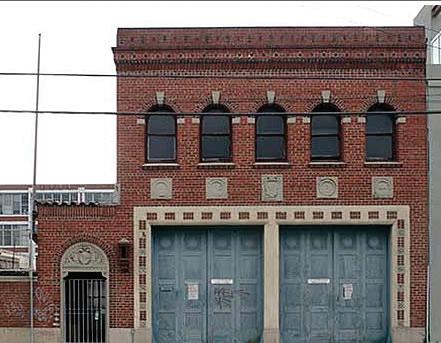
Scott Smith in Gus Van Sant’s Milk
As a teenager growing up near San Francisco, Franco’s personal connection to Howl included pilgrimages to City Lights. The impressive cast includes David Straithairn, Jon Hamm, Bob Balaban, Mary Louise Parker, Treat Williams, and Allesandro Nivola.
Although the film was shot exclusively in New York, the filmmakers reported that they’d been sustained by the Hill’s many restaurants, including Axis Cafe and Chez Papa,
and had used the theatre at Thick House for James Franco’s screen tests, make-up tests, and rehearsals. Epstein quipped that the film’s intended audience was the same for all his productions: “The world.” He quickly amended his response to focus on “young people.” Added Friedman, “I hope audiences will relate to it as the story of a man finding a way to be true to himself. Allen Ginsberg was searching for a way to express fully who he was; and in doing so, he changed himself and the culture.”
The View asked Hill resident and
career expert Mauri Schwartz, President / CEO of Career Insiders, www.CareerInsid
ers.com, to answer questions from job seekers. Submit your questions toeditor@potreroview.net.
Q: I’m sick of my job, and want to do something new. Do you have any advice?
A: At some time in their careers, most people come to a point when they’re so unhappy with their jobs that they want to make drastic changes. Many find they have a strong passion for another field. However, most of the time, they can achieve change, and job satisfaction, without taking such drastic action.

It’s essential for someone in this situation to dig deep to discover the real reason s/he is unhappy before proceeding down a path to change careers.
Keep in mind that organizations hire you because you’ve proven from your experience and achievements that you can be successful in their organization; not for what you think you can do. This is especially true today’s tight job market.
Ask yourself:
you should be getting?

• days, nights, and weekends?
Are you working too many long
• more than you’d like?
Are you required to travel
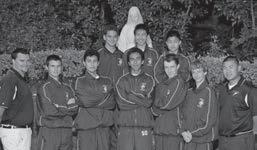


• you’d like?
Are you commuting more than
Do you have the necessary
• skills and/or tools to be successful?
Are you spending too much • of your time doing tasks that you hate?
Do you have ethical or moral
• conflicts with your manager or the company?
Then ask yourself: If I could change anything
• about my job what would it be?
Is there a realistic chance
• of successfully making this change?
There are several options to take before giving up entirely on your current career:
Have a conversation with your
1. manager and ask if there’s a way to get what you need. Look for other opportunities in
2. the same company. Look for similar opportunities
3. in a different company, industry, or location.
“What’s the primary reason
• I’m unhappy?” “Burned-out” is not a reason.
A recent New York Times article quoted Barbara Safani, owner of a career management firm in New York, “’A lot of people who say that they hate what they do actually hate who they do it for.’ In that case, she said, they need to work on managing their relationships rather than changing careers.”
Are you not getting enough
• recognition/respect from your manager? Upper management? Your colleagues?
• enough, or what you think
Are you not getting paid
If after doing this analysis, you still feel strongly about pursuing another career, perform your due diligence. Thoroughly research the field, including talking with people in that line of work to learn what it’s really like.
Editor’s note: in response to last month’s call for short fiction stories we received this non-fiction essay, which we’re happy to print. Please submit your story to editor@ potreroview.net.
It was the perfect signal: if the porch light was on it meant “Don’t wait for me; I won’t be jogging with you this morning.”
It was the 1970s. Hippies were wearing flowers in their hair while stoned out of their minds. Timothy Leary was dropping acid. Open marriage was all the rage. Fortunately for us, so was exercise and the search for eternal youth. Figuring that getting in shape would be safer and more rewarding than the other options, my friends and I decided that jogging was the thing to do.
We were four neighbors: an orthodontist, real estate broker, physician and me. Unshaven, unruly, out of shape and half asleep, we met three times a week to huff and puff our way up and down the neighborhood streets. As time went by we got good at it, began enjoying it and
looked forward to running. We even got to the point were we could carry conversations without passing out from lack of oxygen.
I was known to occasionally turn on that porch light and skip a run. On one particular morning the porch light went on with good reason: we were leaving for Hawaii later that day. A few minutes after our appointed jogging time, I heard some strange noises outside my bedroom window. It sounded like Hawaiian music. I went down stairs, opened the front door and there, hiding in the bushes, were my three resourceful friends. They’d brought a phonograph player, unscrewed the light bulb, plugged in the player, and started to serenade us with “Tiny Bubbles.”
My surprise paled in comparison to their horror when suddenly the automatic sprinklers went on at their appointed time. Their first reaction was to run away; then they realized that the player was drowning. We all roared with laughter as they took off. We finished packing and headed for Maui.
A few months later we gathered to celebrate the fact that we’d sur-
vived our first year together and no one had collapsed. We exchanged presents. In addition to a new pack of light bulbs I was given a trophy shaped in the form of the rear half of a horse, appropriately inscribed “The Half Assed Jogger.”
Our group has long since disbanded. The physician retired, the broker passed away, and the ortho-
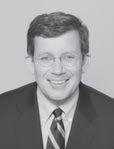
dontist leading the good life. The trophy sits quietly nestled in my office drawer, along with my spare staples, old tapes of dictated messages, and scores of junk too precious to discard. Perhaps I’ll place a note in my will reminding my heirs to hold on to that half a horse as a reminder that good times come and go but fond memories are never forgotten.

This year’s Power to the Peaceful Festival was better attended than ever before. In fact, it almost felt uncomfortably crowded. People of all ages, types and backgrounds were drawn to Golden Gate Park by the healthy food, relaxing massages, fun entertainment, exotic crafts and good music. The masses of people at the event, however, degraded the experience. Luckily, the festival’s headliner, Michael Franti, plays music that can temporarily make audience members forget how crowded it was.
San Franciscans know how to enjoy a day at the park. They also know how to fill it with litter. As soon as the festival was over people dispersed, stepping right over the rows of trash on the ground. A few good citizens helped clean things up with large trash bags.
Overall, however, there were lots of hugs and happy fans singing along with Franti, especially to the songs from his latest CD, The Sound of Sunshine

This home recently attracted 5 offers and sold for $1,111,111—more than $110,000 over the listing price.

fighting Hepatitus C. Estranged from his daughter, divorced and depressed, Ferrante knows life can be better. He stumbles into raw, vegan restaurant Cafe Gratitude, whose founder, Matt Engelhart, lived on Wisconsin Street. As Ferrante befriends the staff –including Engelhart’s son Ryland, brother Cary Mosier, and best friend Conor Gaffney – he finds an escape at the cafe from the chaos and deterioration of his own life.
May I Be Frank documents Ferrante’s emotional roller coaster ride as he embarks on a mission to get healthy, eat only a raw, vegan diet, and drops from 287 pounds to 177 over the course of 42 days. The film captures the sometimes shocking but always humbling story of a man who wants to fall in love one more time before he dies, but knows “no one will love me looking the way I do.” Three of Cafe Gratitude’s 20-something employees become his spiritual and physical coaches. An agreement is made that for the next 42 days, Ferrante will eat only raw food, practice the Cafe Gratitude way, visit holistic healers and get a weekly colonic.
cOllege from page 9
students and graduates work sideby-side with their doctors. Again, that was impossible just a few years ago.”
Besides the health of patients, ACTCM works to preserve the planet’s health by promoting ecologically sustainable medicines and protecting endangered species. ACTCM works with the World Wildlife Fund and the Save the Tiger Fund, among other international organizations, in efforts to ban the use of tiger bones, which have been used to treat rheumatism and arthritis. Huang, who is a renowned leader in TCM and global conservation, said ACTCM promotes the use of artificial bones and a variety of Chinese herbs and other products as substitutes for use of tiger bones.
“It’s a challenging environment for herbal medicine,” said Huang, who has served on the national council for the World Wildlife Fund and is a much-sought speaker in China, Hong Kong, France, Brazil and the United States. “We’re working to change minds, and practices that have been in existence for hundreds of years.”
letters from page 2
their nannies.” I didn’t see this at all. I would bring my daughter and stay for hours while she played. There were no nanny drop-offs, and there were plenty of teens and children from the projects. The directors were involved, fun, caring, and responsible, doing a difficult job. During the summer camps, when many of the children arrived having not eaten breakfast and without a lunch for the day, the directors would provide them both, often with their own money. There were also regular field trips to pick berries, go fishing, hiking, and bowling.
The latchkey program was organized and reliable, offering sports, crafts, and just playing around. When my child changed schools from Starr King Elementary I still brought her to Potrero Rec latchkey because it offered so much and I could trust everyone working there. Despite the staffing shuffle and budget cuts, there are still people working at the center who are dedicated to the kids and the community. They need our support.
Black Green PMS 382 Red PMS 185
The true story of the transformation of morbidly obese 54-year-old Frank Ferrante, ex-junkie, photographer, parent and San Francisco State student, is lovingly and entertainingly told in May I Be Frank This emotionally engrossing film marks a debut by the scions, employees and friends of the Engelhart family, owners of Cafe Gratitude in the Mission.
Brooklyn-born Sicilian-American Frank Ferrante is an earthy and profane lover of life, beautiful women and a good laugh. He’s also morbidly obese, a drug addict, pre-diabetic and

Setting out to help Ferrante lose weight, the three friends decide to document the process, not anticipating that his profound journey would inspire them to make a serious film. May I Be Frank has won the support of locals, Cafe Gratitude staff, and actor-activist Woody Harrelson, musician Alanis Morrisette, as well as authors Alice Walker and Dan Millman.
The film screens October 17, 22 and 25 at the Roxie Theater, as part of the ninth annual San Francisco Documentary Film Festival. For more information and tickets: sfindie.com, maibefrankmovie.com or 1.800.838.3006.
ACTCM is working with the City and County of San Francisco to obtain green certification, and is a member of Co-Op America’s Green Business Network. The college maintains an organic herb garden.
ACTCM’s clinic is located at 450 Connecticut Street; www.actcm.edu.
Lis Worcester 17th Street
We welcome your letters. Please send all correspondence to editor@ potreroview.net or Attn: Editor, The Potrero View , 2325 Third Street, Suite 344, 94107.
RGB Green (184, 218, 25) Red (241, 26, 10)
CMYK Green (28, 2, 96, 0) Red (5, 90, 95, 0)
only$60
(some models slightly higher)
Black
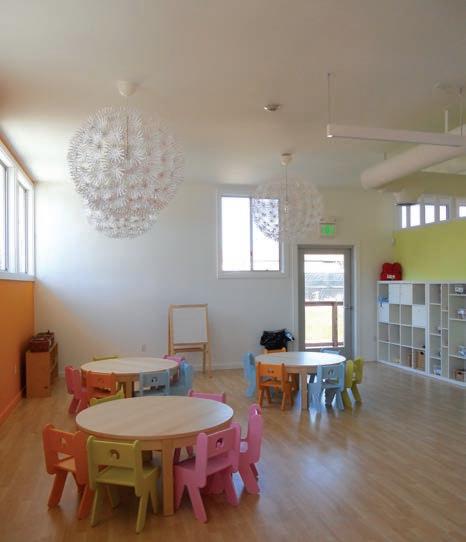 By Joe Prosper
By Joe Prosper
Editor’s note: To diversify our offerings, the View is publishing works of short fiction, less than 1,000 words. Submit yours to editor@potreroview. net
My mother died when I was ten, and people tell me I haven’t been the same since. I can’t recall any particular change, but looking through my old school report cards, I found signs of something wrong. Before mom died I was an average chatty student. My elementary school grades hovered in the low “Bs.” Written on almost every card was a comment from a teacher: “Michael’s work has improved, but he still talks too much in class;” “Michael needs to work on his concentration: school is not a social hour.” After mom died, the notes changed, and so did my grades. I no longer talked too much. Instead, “Michael is very quiet in class, but when he does participate he’s usually very thoughtful.” The Bs turned to Cs, and sometimes Ds. I didn’t get good grades again until high school.
he’s trying to catch his breath, and you worry that maybe he won’t be able to.
My memories of my father are equally sketchy, with one exception: my dad’s hobby. We weren’t poor, but dad would do almost anything to get something for nothing. We’d drive thirty miles to go to bank openings, just to score some complimentary cookies and punch. If a grocery store was giving out free samples, dad would take three, and make sure my sisters and I got plenty as well. Every week I’d find my pockets stuck together with some sticky free thing my father insisted I take. He signed us up for every birthday club on the planet, herding us in to get our free ice cream at Baskin Robbins, or pancakes at the International House. Whoever wasn’t the designated birthday kid would sit and watch, nursing a glass of ice water, while the lucky one scarfed down their treat.
La Piccola Scuola Italiana, the Italian immersion preschool, recently opened its new facility at the corner of 20th and Tennessee streets. The 6,000 square foot building previously housed Concentra Urgent Care, and was redesigned by Italian architect Michele Zini, who is a world expert in Reggio Emilia-inspired school design. The preschool offers early childhood education and afterschool programs in Italian to children from 10 months to seven years old. Photograph by Lisa Tehrani.
I can remember the theme songs from my favorite television shows better than any interactions with my mother. Mom was always around –cooking, reading pulp fiction, watching TV – but she never said much, at least not to me or my two sisters. When I think about her death, it feels soundless, but scary, like the few seconds of quiet during a baby’s tantrum, as
Our house was filled with calendars advertising insurance or the local real estate agent. We had logoed buttons, stickers, pens, and pencils; posters on our walls with big shiny trucks on them, or giant bottles of beer. It wasn’t until I’d reach puberty that I discovered that ketchup came in bottles, not miniature plastic packets. Even our toilet paper – the kind segmented into tiny squares – came courtesy of public restrooms.
A few months after mom died dad started hiring a series of housekeepers to cook and clean. As each one inevitably moved on he kept employ-
Rose Ellen Alexander, Kansas Street
Aida & Rollin Anderson, 19th Street
Riley Bartlett, Wisconsin Street
Judy Baston, De Haro Street
John Borg, Illinois Street (Eco-Imprints)
Susannah Bruder, Mariposa Street (Yogasita)
Diana Bunimovitz, Arkansas Street
Florindo Cimino, 20th Street (Flo’s Barber Shop)
Marty Cobb, 20th Street
Rick Cobb, 20th Street
Paul Conrad, Carolina Street
Theodore Conrad, Carolina Street
Margo Crouppen, DeHaro Street
Justin Davis, Kansas Street
Philip De Andrade, Mission Creek (Goat Hill Pizza)
Peter Diaz, Kansas Street
Eugene Dickey, De Haro Street
Yuhum Digdigan, San Bruno Avenue
Babette Drefke, Kansas Street
David Fierberg, Texas Street
Tina Fisher, Pennsylvania Street (Baked)
Patrick Gorman, Arkansas Street
Kent Hendrick, Pennsylvana Street
Mary Hill, Rhode Island Street
Roger Hillyard, 18th Street (Farley’s)
Kayren Hudiburgh, Carolina Street (Good Life Grocery)
Deborah Howard Page, Arkansas Street
Michelle & Justin Hughes, Pennsylvania Street
Carole Hughes, Wisconsin Street
Richard Hutson, Pennsylvania Street
Margret Frings Keyes, Wisconsin Street
Ernie & Paula Kovacs, Carolina Street
Karen Larsen, Carolina Street
Tim Lawe, Pennsylvania Street
Susie Leni, Kansas Street
Judie Lopez, Connecticut Street
Ed Lortz, Texas Street
Daniel Lyon, Pennsylvania Street
Sherron Mills, Wisconsin Street
Lucy & Dennis O’Connor, Carolina Street
Maureen Oddone, Wisconsin Street
Susan Olk, Missouri Street
Andrea Ortega, Pennsylvania Street (Baked)
Betty Packard, De Haro Street
Lael Robertson, Missouri Street (Big Think Studios)
Ed Rudolph, Texas Street
Mauri Schwartz, Carolina Street (Career Insiders)
John Scola, Missouri Street
Marc Simon, Rhode Island Street
Bill Slatkin, Indiana Street
Simon Stahl, Kansas Street
Virginia Sustarich, Vermont Street
Steve Voris, De Haro Street
Peter Walbridge, Missouri Street (Big Think Studios)
Pamela Wellner, De Haro Street
Lyllian Wendroff, De Haro Street
Judy West, Potrero Avenue (Belle Dolce Chocolates)
Jane & John Westfall, 20th Street
John Weston, Vermont Street
Sarah Wilcox, Carolina Street
Tia Winn, 20th Street
Lester Zeidman, Carolina Street (Good Life Grocery)
Samantha Zuvella, Utah Street
• Rescue MUNI
• United Healthcare Workers – SEIU
• Carpenters Local 22
• Laborers’ Local 261
• Raoul Wallenberg Democratic Club
• Sierra Club (3rd Choice)
• United Association of Plumbers Local 38
• San Francisco Police Officers Association
• San Francisco Neighborhood Newspaper Association
• Designated ‘Park Friendly’ by the Neighborhood Parks Council
• Sean Elsbernd, San Francisco Board of Supervisors, District 7
• Michela Alioto-Pier, San Francisco Board of Supervisors, District 2
• Milton Marks, President, Board of Trustees, San Francisco City College
• Mary Jung, San Francisco Democratic Party Central Committee, AD 12
*Partial Lists


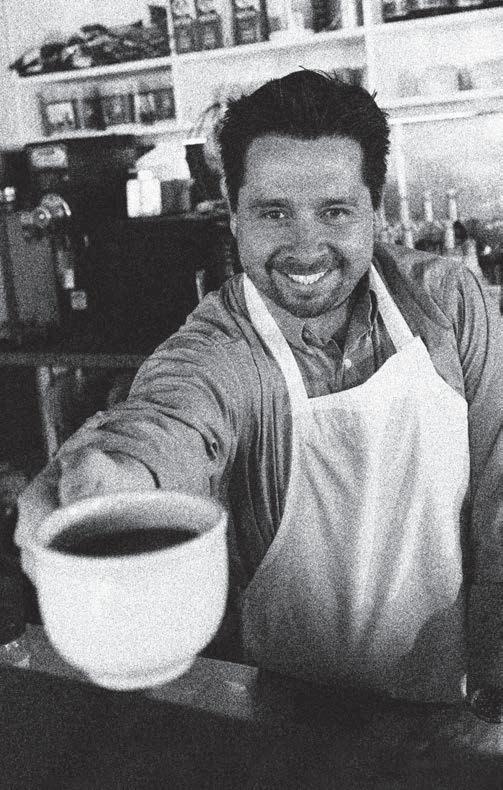

Three Cups of Tea and Beyond: Travels in Pakistan with Julia Bergman. As board director (1997-2009) and board chair (2003-2009) of the Central Asia Institute, Julia Bergman will share her experiences in northern Pakistan developing teacher training programs and creating The Balti Workbook, a collection of short essays and classroom assignments about the history and culture of Baltistan. Her talk will be accompanied by photographs of maps, schools, teachers and students from the region. October 23, 4 to 5 p.m.
Water is Life. Pass It On: A Discussion by Blue Planet Network. Unsafe drinking water is the world’s leading cause of sickness and death, but solutions are available for as little as $30 per person. Lisa Nash, CEO of Blue Planet Network, a Bay Area safe drinking water nonprofit, will take us on an amazing photographic journey of the beauties and tragedies of water and the great things individuals are doing to save it around the world. October 30, 4 to 4:45 p.m.
children’s programs
Baby Rhyme and Play Time. For infants up to eighteen months old and their caregivers. Tuesdays, October 5, 12, 19 and 26, 1:15 to 1:45 p.m.
Family Storytime. Featuring stories, songs and rhymes. For children from birth to five years old and their caregivers. Thursdays, October 7*, 14, 21 and 28, 10:30 to 11 a.m. and 11:15 to 11:45 a.m.
*Both storytimes on October 7 will feature The Snowy Day by Ezra Jack Keats as part of Jumpstart’s early literacy program, Read for the Record: www.readfortherecord.org.
Fun Flicks: The Sandcastle; Why Mosquitoes Buzz in People’s Ears; Diary of a Fly; Duck for President. Fun Flicks is offered every second Wednesday of the month and includes short films based on children’s books and stories. Bring a snack! For children ages five and older. October 13, 6:30 to 7:15 p.m.
Asheba’s Musical Storytelling for Children. Asheba specializes in calypso, the musical and folkloric oral tradition of his homeland of Trinidad. This program will be held outdoors in conjunction with the Potrero Hill Annual Festival. October 16, 3 to 3:45 p.m.
Join Parents for Public Schools-SF for a kindergarten workshop. Hear firsthand experiences from parents about San Francisco public schools and why they chose them. Learn about the new enrollment process. Get tips and advice on key information and resources. Sponsored by Parents for Public Schools, Friends of San Francisco Public Library (SFPL), and SFPL. October 26, 6:30 to 8:30 p.m.
The Potrero Neighborhood Library Campaign Committee meets monthly to discuss fundraising strategies and progress. If you’d like to join the committee, contact Mary Abler at Friends of the Library: 626.7512, extension 107 or mary.abler@friendssfpl.org. H A C
Sponsored by Mainline Security
 By Regina Anavy
By Regina Anavy
On August 19 at 4 p.m., a police officer received a tip that a gun was being stored in a vacant housing unit on the 100 block of Dakota Street, which was illegally occupied by squatters. Searching the premises, the officer found the gun in a purse belonging to someone in the bedroom. The officers then learned that an auto burglary had just occurred where a gun had been stolen. The gun’s legal owner was notified and responded to the scene, where he positively identified the weapon. A suspect was arrested.
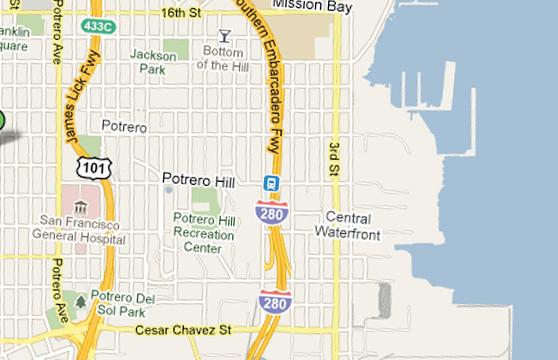
According to Missouri Street resident Mary Wasserman, “On Wednesday night, August 25, I heard a siren. Paramedics and police were assisting someone at 18th and Missouri.” A 51-year-old man was walking in the crosswalk at 10:40 p.m., when he was almost hit by a vehicle. The pedestrian and driver yelled at each other, witnesses reported, and the driver got out of his car and allegedly assaulted the victim, who fell and hit his head on the pavement. The driver then got into his vehicle and drove away.
Police need help finding the driver. He was described as a white or Hispanic male, 25 to 40 years old, who was wearing a flannel shirt and blue jeans. His vehicle was described as white, either an Acura Integra or a two-door Geo. The license plate began with a 5XM or 5SM. Anyone with information should call the police department’s anonymous tip line: 575.4444, text TIP411, or call Bayview Station, 671.2300.
Mississippi Street resident Ralph Anavy reported that his garage was broken into during the night of September 8, and two car batteries were stolen. “They must have had transportation, because those batteries weigh a ton,” he said. There were four other burglaries reported that same night on Potrero Hill.
According to Deputy City Attorney Yvonne Mere, “recycling theft is a huge issue City-wide. It’s a violation of the Penal Code and a public nuisance. People who steal from the recycling bins are stealing from our City, and we, the bill payers, are the victims.”
“It’s a crime that’s difficult to
prosecute,” said Braden Woods, managing attorney for the District Attorney office’s Homicide and Cold Case units. “We batch the cases, which means we have to get the suspect two or three times. The first time the person comes through for stealing cans, if they don’t have a prior record, we don’t prosecute. We understand they’re just trying to make it. If they keep being reported, on the second or third time, we’ll put all the cases together. But we’d rather get the guys who hire these individuals. They’re the ones who sit in the trucks at the end of the block.”
“On Sunday mornings a lot of these trucks are parked outside a house on 25th and Wisconsin,” said Jane Fay, president of the Parkview Heights Homeowners’ Association, which manages a development of 120 townhouses on the south side of Potrero Hill. “There’s broken glass and trash on the street and homeless people rummaging around.”
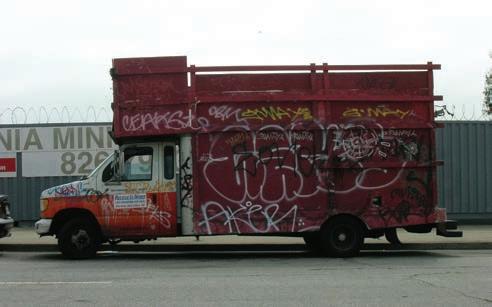
“If you can get the license plate numbers, that’s something we can use,” Woods said. “Just don’t put yourself in harm’s way.”
Two juvenile males, 13- and 14-years old, and one adult male, 22-years old, were taken into custody after allegedly attempting to rob a female Internal Revenue Services
agent at gunpoint on August 4 in Hunters Point. One of the juveniles, who suffered a gunshot wound, was scheduled to be charged at the Youth Guidance Center on September 2, according to Reverend Shad Riddick, a friend of the family. “The hearing was cancelled,” he said. “The boy was in pain and was sent back to the hospital.”
On September 15, after midnight, a 36-year-old woman was walking in the 2200 block of San Bruno, when someone came up behind her, stabbed her in the neck and grabbed her purse. The assailant was described as an African-American male, six-feet-tall, 20 to 25-yearsold, with short dreadlocks. He was seen running toward the Mission.
The victim was transported to a hospital, where she underwent surgery. According to San Francisco Police Department Captain Greg Suhr, “We believe this is the same suspect who has committed several robberies in the last six weeks and are working with informants to identify him. We will provide additional police attention for this area, especially in the evening, until the suspect is in custody. If you see anyone fitting his description, please call 911. Try to get a look at his shoes; this can sometimes be an identifying factor.”
AssAulT: 1822-18%
FiGhT NO
weAPONs: 4250-16%
burGlArY: 1913+46%
GuNshOTs: 78-12.5%
rObberY: 511-54.5%
TheFT: 3731+19%
VANDAlisM: 71+600%
OTher: 101145-30%
“Content” at the opposing long points. John views the teacher-student relationship as the center of the instructional core. Necessary interventions happen along the adjoining bars, but not so that they tip the balance of all the points, and especially not the center bar that holds teacher and student together.
Originally from Southern California, John studied music and plays the piano. He earned a masters in creative writing while obtaining his teaching credentials at San Francisco State University. His thesis advisors were authors Myong Kim and Francis Mayes, the latter of whom wrote Under the Tuscan Sun. John runs five miles daily, and maintains a poetry blog.
John spent 13 years teaching high school in the East Bay and Southern California before entering the principal track. Before accepting the Starr King post he’d been working at a foundation supporting education reform. But he realized that his passion was with families, teachers and kids. “I like the real stuff; this is where the real payoff is.”
“Bodies have wisdom,” asserted John. He believes in whole body health and mind. To that end, a group called PlayWorks: Education Energized has been brought to the school to offer organized play and exercise during morning drop-off and recess. The program has a set of rules – have fun; respect the game; respect each other; play hard – that John hopes
will support social and educational engagement. He wants kids to have fun, but with structure.
John anticipates a future in which women and people of color take an equitable place at the table. Secondlanguage proficiency will be fundamental. As he sees it, “crazy logic” is at work in this emerging new world in which parents know they must prepare their children to survive while their own foundations are fast becoming irrelevant. “How do you pull the rabbit out of that hat?” he mused, with a wry but earnest smile.
In addition to his vision of an instructional core, John hopes to take lesson planning, implementation, and assessment to a new level of iterative design and assessment. While teachers typically don’t like being assessed, they like knowing what works and what doesn’t. A recent Time Magazine series pointed to the breakdown of teacher unions as a triumph for education reform without highlighting the complexities of assessment. But most observers agree that there are no solid practices for training and retaining teachers, with even heralded programs like Teach for America having deplorable retention rates. Collaboration and iterative professional development cycles—the same secrets of success in designing smart phones or treating hospital patients— are critical. “My job is to hold that container together so that the team process is rigorous,” John said.
Assessment methods have become more sophisticated. Students can be evaluated based on their learning styles, not just marked as achiever,
average, or under-performing. This kind of information gives teachers the nuance they need to create individualized learning. John is intrigued by School of One, a program being piloted in New York which combines teacher-led class instruction with one-to-one tutoring, independent learning, and internet-based virtual tutoring. “I have to work with the tools I have. Our school will find its own path to excellence,” added John.
John believes in intuition. Rosenberg had been at the school for 13 years. Two previous candidates refused the job. Meanwhile, John was realizing things weren’t clicking for him at the foundation. He put feelers out to see if he could be a principal again. It was the right time, and the right place.
John is a longtime San Francisco resident and former principal of Treasure Island School. “This is my town, and now this is my school,” he said. It has “the raw stuff that a school needs to be a top-notch performer.”
Renee J. Tan, parent of two Starr King Mandarin Immersion students, appreciates how John has hit the ground running. “He recognizes the different needs for the four different programs at the school, and he has already made some adjustments. I especially appreciate his insight into the rewards and uncertainty that parents experience with a new program like ours.”
After one recent school day John visited the home of a student who’d been suspended. He wanted to check in with the mother, and make sure she
knew that the child was expected to return to school the following day. “It doesn’t work if you don’t,” he explained. “It’s all personal now. You can’t do it mechanistically. The world is too disconnected at this point. They have to know you and make a connection.”
John is impressed with the Starr King faculty’s dedication. When he left the school at 7 p.m. one evening he found he wasn’t the last one remaining in the building. “To get there, we have to get there together. All the pieces have to connect. Starr King is a joint effort – kids who connect, adults who feel their kids connecting – things start to generate their own reason to be,” he said.
Prop B will double health care costs for thousands of children, spouses and domestic partners of San Francisco School, Community College, Superior Court and City workers — regardless of their ability to pay.
The real impact of Prop B on working families is staggering. Under Prop B, a single mother with one dependent could be forced to pay up to $5,600 more per year for health care — in addition to the $8,154 she already pays. Many other employees will see their costs more than double.
Prop B forces the custodian making only $40,000 per year to pay the same hike in health insurance premiums as the top brass, who could be making three times as much. Many of these workers are already struggling to afford health care, and this literally takes food off their table.
Prop B was so poorly written, the Director of the San Francisco Health Care Service System has written it could make the City ineligible for more than $23 million in federal funding for health care next year and up to $100 million over the next four years.
California Nurses Association
United Educators of San Francisco
San Francisco Democratic Party
House Speaker Nancy Pelosi
Mayor Gavin Newsom
State Senator Mark Leno
State Senator Leland Yee
Assemblyman Tom Ammiano

Sheriff Michael Hennessey
Board President David Chiu

ing different help, until finally us kids quit, and left home. Gretchen, a fat woman with salt and pepper hair, worn bowl-cut style, was our first maid. She lived down the street with her two daughters, Eileen and Debbie Sue, who were about the same age as my sisters. My older sister, Elizabeth, called them“white trash,” which at the time was a phrase I didn’t understand. I imagined piles of old milk bottles, cardboard, and ancient white enamel appliances, and couldn’t figure out what that had to do with Eileen or Debbie Sue.
Gretchen scared me. Almost every day she’d grab me by the neck, hard, and exclaim, “You’re so precious! I wish I had a boy!” I’m going to steal you away during the night!”
I couldn’t imagine a worse fate than being kidnapped by Gretchen and being forced to live with Eileen and Debbie Sue in a small crowded house surrounded by white trash. After less than a year, Gretchen’s husband got a job at Sears, and they moved to another suburb. We never saw them again.
Following Gretchen was Mildre, a Latina woman who spoke little English, and who resented having to work for us. She’d slink around the house like a burglar, as if any moment she might be caught and charged with impersonating a maid. Or she’d act like we didn’t exist at all. If I walked into a room she was cleaning she wouldn’t bother looking up. After Gretchen’s
greedy arms, I was relieved by Mildre’s stealthy presence. But she only lasted a few months before dad let her go. He didn’t tell us why he fired her, but we whispered to each other that she must have been stealing. My sisters said they were glad to see her and her moroseness go. But I secretly missed her awkward silence and the way she subtlety disliked us. It made sense to me.
Then there was Billy, a skinny woman with tattoos. She spent a lot of time watching TV and smoking handrolled cigarettes, and would regularly wander out to the backyard and spit chunky gobs of tobacco. One day she didn’t show up, leaving behind crusty blobs of tobacco juice for my sisters and I to occasionally discover while playing outside. We called them “Billy Blobs,” and made a game of who could find the most, until, finally, they too disappeared.
Wendy, an older Chinese woman who scolded us for not cleaning up after ourselves, came next. Wendy was a devout Christian, and was always after us for cussing, which made us cuss more. We liked to hide her rosary beads, and once stapled a Barbie doll to a Popsicle stick cross, squirted it with ketchup, and hung it in the living room. Following each of these incidents Wendy would suck in her breath, mutter a silent prayer, and hiss that we were heathens. After a blow-out argument with Elizabeth, Wendy stormed out, telling dad that she’d rather visit Hell than continue to work for us.
Wendy was eventually replaced
by Margaret, who was from Barbados. Margaret was young, pretty, and gentle. She’d gather us together to decide what to have for dinner, and enlist us in simple chores, like cutting vegetables or washing windows. While she and Elizabeth didn’t get along – Elizabeth refused to do any of the tasks Margaret assigned to her –my younger sister, Sharon, liked her, and I developed a huge crush on her. When I saw her my heart would beat faster. If she bent over to put down a plate, or help me with homework, my skin would erupt into flames.
One morning, while we were at school, two men knocked on our front door and took Margaret away. Dad said that they were from immigration, and that Margaret had been deported. I begged him to find her and bring her back, but he said there was nothing he could do.
Weeks later Sharon and I were in the living room playing another endless game of Monopoly when Elizabeth walked in and sat imperiously down on the sofa. As usual, we ignored her, until she started giggling to herself, first softly, and then more loudly.
“What’s wrong with you?” Sharon asked, not looking up from our game.
“Oh, nothing,” Elizabeth snorted. “I was just thinking about the expression on Margaret’s face when the cops came to drag her away.” Busted!” she shrieked.
“I don’t think that’s very nice,” I replied stonily, keeping my eyes glued to the deed to Baltimore I held in my hand.
“Of course you don’t,” Elizabeth sneered. “You were always making goo-goo eyes at her. Well, I took care of that. No more, “Elizabeth, would you help me in the garden?” or “Elizabeth, could you turn the oven on?” Who did she think she was, our mother?”
“What are you talking about, “you took care of that?” I asked.
“Well, who do you think called the immigration police?” Elizabeth’s grin was triumphant.
“You finked on Margaret?” Sharon looked stunned. Blood rushed to my face. Elizabeth nodded, smiling. “Aargh!” I leapt across the room, jumped on Elizabeth, and started punching her. We rolled off the sofa, cushions flying.
“Get off of me! Get off of me!” Elizabeth, who was taller than me, and expert at using her nails, scrapped at my arms, leaving deep impressions, and pushed me to the floor. “Get away from me, you little freak!” I lay curled on the carpet. Sharon sat motionless, jaw gaping open. “You’re always sucking up to the maid, acting like they’re our mother, you little twerp. Next time I’ll call the orphanage and get rid of you.” Elizabeth stormed out of the room. I sobbed quietly. Sharon was quiet. After awhile we both went to our rooms.
I didn’t talk to Elizabeth for months after that. We tried to avoid one another, and wouldn’t look at each other during meal times. Eventually, on a family outing to the zoo, we began to converse again. But we never discussed Margaret. And I never forgave Elizabeth.
Prop G says it’s about fixing Muni. But the only thing it does is unfairly go after drivers – while doing nothing about bad management and real problems of Muni.
8 Management is the problem with Muni. The top manager at Muni made $354,000 last year – the highest paid official in San Francisco – yet Muni management gets worse each year.
8 Prop G doesn’t improve Muni management. Prop G does nothing to increase management accountability or efficiency. It gives the bureaucrats a free ride, while going after the drivers as if they are the problem.
8 Muni drivers are part of the solution. Muni drivers are on the front lines, keeping passengers safe, driving our transit routes, helping disabled passengers. They work hard under tough, sometimes unsafe conditions. They’re part of the solution, not the problem.
8 Demand comprehensive, fair reform. Prop G singles out Muni drivers with the most unfair collective bargaining standards of any city union. That’s not fair – and it won’t fix Muni.

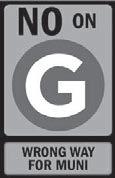
Bayview police s tation c aptain’s c ommunity Meeting is held on the first Tuesday of each month in the Bayview Police Station Community Room at 201 William Street. Enter through the Newhall Street door. Next meeting: October 5th, 6 p.m.
Dogpatch neighborhood a ssociation usually meets the second Tuesday of each odd-numbered month. Next meeting TBD.Voting membership is open to anyone living in or owning property or a business in Dogpatch. For more information or to join/pay online: mydogpatch.org.
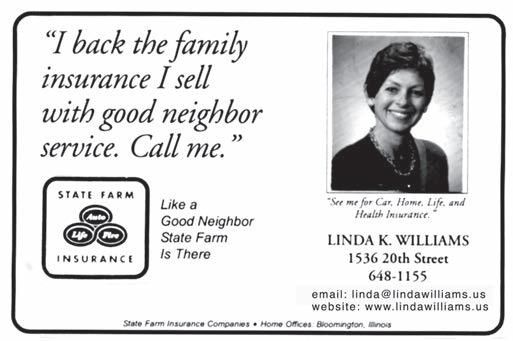
McKinley s quare c ommunity g roup is a communication and discussion group regarding events and activities, clean up days, improvement and beautification, and other concerns, such as crime in the neighborhood. Next board meeting: October 13th, 6:30 to 8 p.m. at Downtown High School, 693 Vermont Street. Board meetings open to the public. Visit www.mckinleysquare.com for more information.
potrero Boosters meets the last Tuesday of each month at 7 p.m. (social time begins at 6:30 p.m.) in the wheelchair-accessible Game Room of the Potrero Hill Neighborhood House, 953 De Haro Street. For more information: www.potreroboosters.org or email president@potreroboosters.org. Next meeting: October 26th.
potrero hill association of Merchants & Businesses meets the second Tuesday of each month at 10 a.m. at Goat Hill Pizza, corner of Connecticut and 18th streets. Visit www.potrerohill.biz or call 341.8949. Next meeting: October 12th, 10 a.m.
potrero hill Democratic club meets the first Tuesday of each month at 7 p.m. at the Potrero Hill Neighborhood House, 953 De Haro Street. For more information: 648.6740, www. PHDemClub.org. Next meeting: October 5th, 7 p.m.
potrero hill g arden club usually meets the last Sunday of the month at 11 a.m. for a potluck lunch in a local home or garden. Discussions are held on organic, edible, or ornamental gardening appropriate for Potrero Hill’s microclimate. Call 648.1926 for details.
s tarr King Openspace The Starr King Openspace Volunteer Work Day is held on the 3rd Saturday of each month, excluding holidays. Meet your neighbors, get some fresh air, and come care for this unique oasis of nature in the heart of the big city. Next Volunteer Work Day: October 16th, 9 a.m. to noon. Meet on the Openspace along Carolina Street, across from Starr King Elementary School. The next Starr King Openspace Board of Directors Meeting is on Wednesday, October 19th, 6:30 p.m. at the Potrero Hill Neighborhood House, 953 De Haro Street. Board meetings are open to the public. While time will be set aside for public comment, the Board may reserve some agenda items for closed session discussion. For more information: www. starrkingopenspace.org; email the Board of Directors at starrkingboard@gmail.com; voice mail 415-6336-SKO (756).
Marin Preparatory School is an independent, non-profit, coeducational school, offering classes from Junior Kindergarten through 8th Grade. Our Mission is to provide opportunities for students to achieve their personal best, become positive, responsible community members, and to embrace learning in a warm and productive environment

• Innovative, Spanish-infused curr iculum

• Nur tur ing the strengths and needs of a diver se student population
• Embr acing local and global citizenship

• Rolling enrollment for Junior Kinder gar ten, Kinder gar ten, and 1st Gr ade
Learn more about our school: Open House: October 14 and 2410:00 a.m – 12:00 p.m. October Parent Tour Dates 10/5, 10/12 and 10/199:00 a.m. – 11:00 a.m. Contact us to schedule a personal school visit.
This is the first in a series of monthly columns that BRIDGE Housing is publishing in the Potrero View to keep all residents of Potrero Hill informed about progress of planning for the rebuilding of Potrero Terrace & Annex and community building efforts.

In August, there were two events focused on developing a new community garden within the Terrace & Annex. The first was a workshop held on August 14th at the Potrero Rec Center where neighbors and gardening experts came together to talk about what people would like to see in a garden to build a stronger sense of community and how to make a garden a vehicle for jobs and education.
as a step towards encouraging use of the field for kids’ soccer games and other sports activities.
Jumpy houses and tile painting provided fun activities for families across the hill. The day was capped off by the first ever outdoor movie night on Potrero Hill! Many hearty souls braved the cold and wind to see Disney’s The Princess & The Frog. We hope to repeat this event next year on an evening with better weather.
BRIDGE has hired a new Community Builder, Emily Weinstein, who started in mid-September. Emily will lead BRIDGE and the City’s efforts to identify and develop programs and activities that will reinforce the social fabric and unite all of the residents of Potrero Hill in common purpose.
On August 21st, the 2nd Annual Community Action Day was held and a raised bed garden was installed at the Family Resource Center at 85 Turner Terrace by a large group of volunteers who hauled wood and soil, installed an irrigation system and planted vegetables. Meanwhile, up at the Rec Center, other volunteers filled gopher holes with dirt on the playing field
With respect to the proposed plan, the application for environmental review was submitted to the Planning Department in late June and a public scoping session will be held at the NABE on November 22nd at 6 pm. This session is an opportunity for the community to let the Planning Department know what issues people are interested in seeing addressed in the Environmental Impact Report.
Stay tuned for notifications regarding the environmental and land use review process and the progress of the community garden. August was just the beginning.
art and Music
ATTENTION ARTISTS Goat Hill Pizza is looking for local artists to show their work at the restaurant. Please call Alicia Wong at 415.641.1440 if you are interested.
Business services
GRAPHIC DESIGN/PROMOTION FOR
YOUR BUSINESS Web sites new and updates. Ads, Logo/Identity, Display, Brochure, Sell Sheet, Flash Animations, more. On the Hill. www.jcarpinelli.com 415 282-5516.
community activities
SENIORS (60+) DON’T EAT ALONE Join us for daily lunch and add to your social life. Mon-Fri, hot nutritious meals--your first time with us you get a free lunch! Bingo, cards, birthday celebrations, special events, and other activities. For more information, call Dolores Maghari at 415.826.8080. PH Neighborhood House, 953 De Haro St.
education
TUTORING Get help with tests & homework. See www.myStudyBuddy.org. Jane Radcliffe, M.A., CA Credential #150007. 415.586.4577.

PART TIME SECRETARY Part time office work/secretary. Exp:ex secty off mgr. Use PC, Word, Publisher, Excel, Lite
bkkping. Compose great letters. Type 100+wpm. Work your office/home,my home. Rose 415-641-9332.

garden services
LANDSCAPE DESIGN Growsgreen
Landscape Design offers a custom design for your garden. Award winning designs, featured HGTV designer. Porfolio: www. growsgreen.com, beth@growsgreen.com 415-336-9829.
EXPERT GARDEN & LANDSCAPING
SERVICES We do design and installation; Regularly scheduled property & garden maintenance; Tree & shrub pruning; Irrigation & lighting systems installation & repair; Stonework & hardscaping; Cleanups & staging. No job too big or too small. Extremely detailed oriented. Sixteen years in the business; Call David @ 415.846.7581 http://www.shapeoftheearth.com
TOM’S PLUMBING Tom has been satisfying Potrero Hill customers for over 30 years. All plumbing needs handled promptly and efficiently at a very low cost. Keep it local and call Tom Keats: 415-824-3538.
HANDYMAN EXTRAORDINAIRE! 20 years experience repair, remodeling. Elec, plumbing, light fix. Anything doors! Double-hung windows. Cabinetry, Decks, staircases MMcQuate@gmail.com. Mike (415) 308-2380.

180 COLOR & DESIGN Our philosophy at 180 Degree Design is to use color
to transform home and business spaces in ways that work for you. Choosing the right paint color can be extremely frustrating for many people, we can help you avoid costly mistakes and achieve the best results for the interior or exterior color of your home or business. Contact us 415285-3014 www.180color.com
E M S PLUMBING Licensed contractor for your plumbing needs. Selling your home and need to replace toilets? 4th generation Potrero Hill resident. Doing it right the first time! ED 596-0883 Lic#945019.
J. A. EMMANUEL CONSTRUCTION
License #861994 is organized to provide service with optimum efficiency and flexibility. Quality work with experience in residential construction can help make your dreams a reality. New construction, house addition, remodeling and conversion. House, apartments, condos, kitchen, bathroom & more. Reasonable rates. All insurance necessary for the projects. Call 415.902.2469 for FREE ESTIMATE or visit www.jaemmanuelconstruction.com.
housekeeping
CLEANING PROFESSIONAL 25 years
Experience. Apartments, homes, or offices. Roger Miller, 415-664-0513 or 7944411 9a-5p.
DO YOU NEED HOUSECLEANING? We will do it for you. Call Sara & Marco 4153108838.
rentals
SPACIOUS AND BEAUTIFUL Furnished guest garden apartment. Private. 1/2 blk. to restaurants. Non-smoking. 2 people. 415-861-3208.
SPECTACULAR CITY VIEW $750.00 per month. Share a very private 3Br/2Ba apt. w/2 easy going middle aged men. Utilities incl. 420 friendly. Laundry facilities. 415.641.1488
VACATION RETREAT FOR POTRERO HILLIANS. Calistoga/St Helena area 3 bdrms 2 baths sleeps 6 (max). Lrg decks w/ views of stream woods & meadow. Frplace w/wood, 30 acres trails, all-year stream. Dogs OK. 3 night wkend=$500 Week=$900. Discount for repeat guests. Photos: spot02.googlepages.com. 415.647.3052.
CHARMING GARDEN APARTMENT
One BR, 2-night minimum. Fireplace, patio, deck, French doors. 415.641.4488
ACTIVSPACE FOR ART, HOBBY & BUSINESS. Rent from $395 a month utilities included. Private, Secure, Affordable, 24/7 access. Call Tama for further details 415-355-1515.

GARAGE WANTED. Garage Wanted. Very responsible Potrero property owner needs secure, clean garage/parking space on Potrero Hill for seldom used small car. $100 reward possible for info leading to rental. Contact Peter at 550.0345 or peut@ pacbell.net.
COMPUTER PROBLEMS DRIVING
YOU BUGGY? Problems fixed! 25 years of industry experience. Personal IT consulting to small businesses or busy professionals. We can install and/or help shop for computer/network/printer or setup/troubleshoot wireless networks. If you’re not technical, don’t worry we are. Rob 415.935.3305 rob@ sfcomputech.com
STEREO REPAIR / HOME THEATER
INSTALLATION Gene’s Sound Service offers expert component-level repair and installation of audio, video and home theater systems. On-site service with convenient day, evening or Sat appointments. Many local references. “Gene’s honest and knows his stuff. Give him a try.” Bobby McFerrin. Call Gene at 415-3771258. More info at www.genessoundservice.com.
MAIL OR CALL IN YOUR AD View Wants Ads 2325 Third Street, Suite 344 San Francisco, CA 94107 415.626.8723 / office@potreroview.net
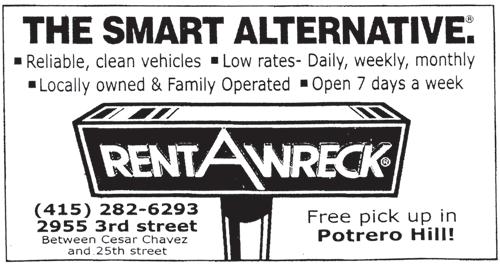
* Payments and/or text changes must be received by the 18th of each month for ad to appear in the following month's issue.
October 21, 1996 - September 15, 2010

Boo knew everyone and everyone knew Boo (along the 18th Street corridor).
- Natalie and Jim




















